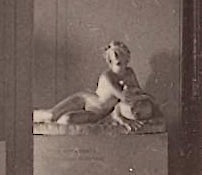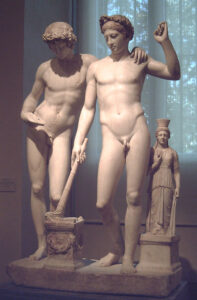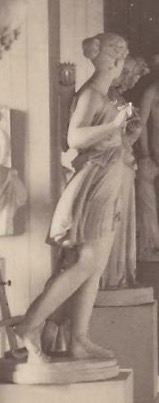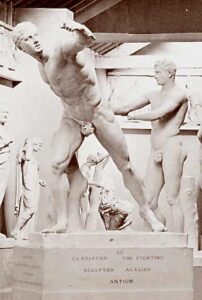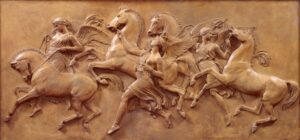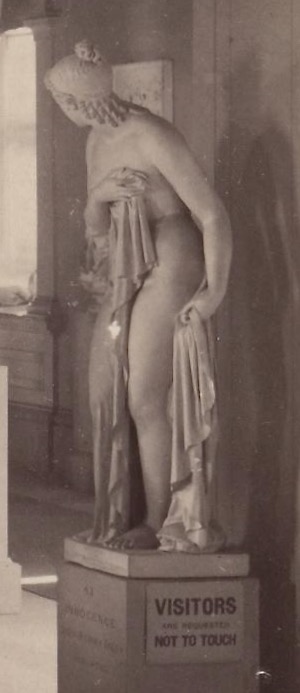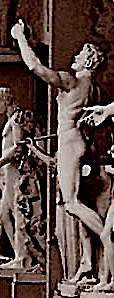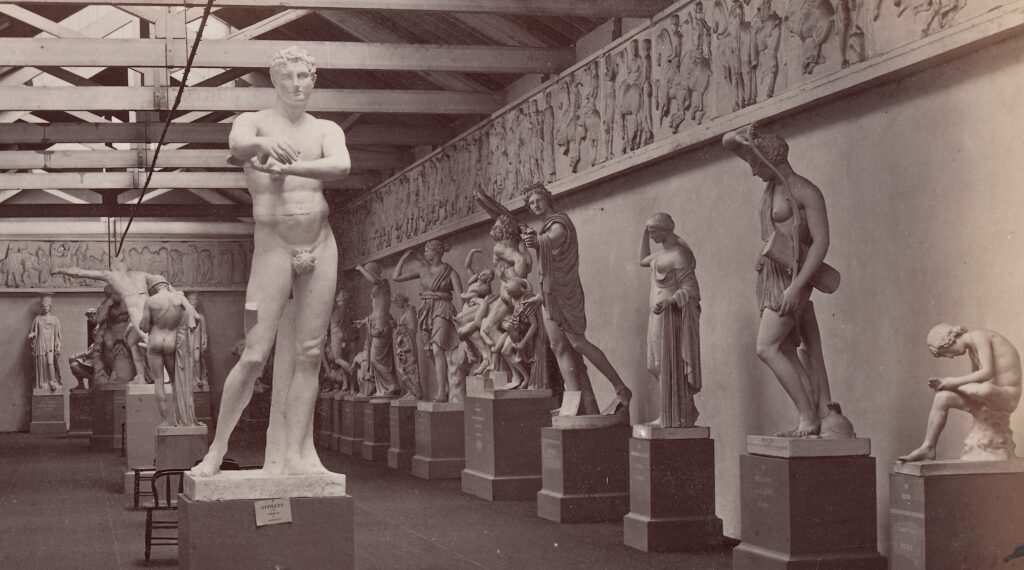
Casts are listed alphabetically by title, as they were in Melbourne’s early catalogues (1865 etc.). Dates of acquisition, e.g. {c.1860}, apply to the casts, which were purchased unless specified as donations (for details of individual donors, see Casts – Donors). For other general matters, including references and abbreviations, see Plaster Casts (introduction); see also Casts – II. Busts & heads.
Where possible, casts are reproduced from the images of them in the early engravings and photographs of the Melbourne collection: see Casts – Overviews. The photo above (a detail of no.6 in that group), shows a characteristic assemblage from the early 1870s, with the recently-acquired cast of the Apoxyomenos (“Athlete”) (I.16) in the left foreground, the Spinario (“Boy extracting Thorn”) (I.24) at the far right, and various other recognizable antique statues and groups, below the Parthenon frieze casts (I.90). Most of the casts were the same size as the originals (something Redmond Barry specifically requested, although in the case of Laocoon the size of the original seems to have necessitated a reduction in scale). Nevertheless, the group shown here brings to mind Australian novelist George Johnston’s later memory of the “Antique School” as “…an unnerving, jolting sort of place, because nothing really agreed with anything else, and one had no sense of harmony or of proportion or of perspective; one’s eyes would move uneasily from dwarfed foreground figures to gigantic shapes in the far distance…” (My Brother Jack, 1964, ch.6). There is some exaggeration here, but Johnston does pinpoint one of the difficulties involved in this sort of display (which also applies, of course, to any museum display of a variety of works drawn from diverse contexts).
Very few of the casts can now be confirmed as extant (see e.g. I.15, I.90 and I.98). Later references to individual casts in annual reports etc. are noted; however, it is not always clear which casts are meant – as in the mention of “a couple of Venuses” in “Municipal Statuary” (1908), or an unspecified Diana as lent to Bairnsdale in AR 1906.
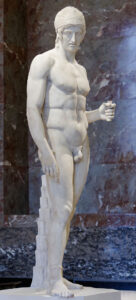
Summers list 1861, no.14 (“legs broken from plinth”); NGV 1865, no.1; AR 1870-71, p.36 (6’11” high; via a Louvre original); NGV 1880, p.4); NGV 1894, VII.82
[photo: Borghese Ares (Louvre)]
AR 1870-71 indicates that the source of this cast was an antique statue in the Louvre. The most likely candidate would appear to be the figure known as the Borghese Ares (Louvre no.866), acquired in 1807, regarded as a Roman copy after a 5th-century BC original, and sometimes identified as Achilles (see for example the comments on the plaster cast of this figure held in the Cambridge Museum of Classical Archeology, no.193, supplied by the Louvre in 1884: refer online catalogue); the heights also correspond (c.2.1 m = 6’11”).
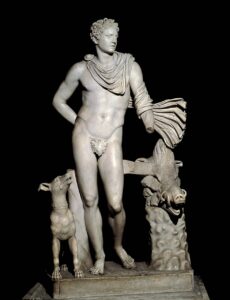
NGV 1865, no.2; AR 1870-71, p.36 (5’8” high); NGV 1880, p.4; NGV 1894, VIII.46; cf.Brucciani (1870?), p.7
[photo: Vatican statue]
The Melbourne references identify the source as the statue shown here, first documented in the 16th century, and in the Vatican since 1770 (apart from an enforced stay in Paris, 1798-1815). The figure is now seen as a Roman copy after a Hellenistic original, modified by the added dog and boar (apparently the basis for a later identification as Meleager): see Haskell & Penny 1981, cat.60.
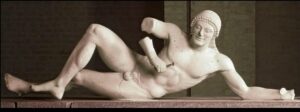
SB p.418 (with added notes as cited below); AR 1881, p.56; NGV 1894, VII.110
[photo: detail of warrior from west pediment, c.500 BC (Munich)]
This group of 15 figures formed a notable addition to Melbourne’s cast collection, on several counts. First, they were among the few antique casts in the collection not to be based on Roman copies. Unusually, too, they reproduced early Greek works, dating from the transition from late archaic to early classical style, around 500 BC. Originally from the pediments of the Temple of Aphaia on the island of Aegina, the two groups of figures, depicting episodes from the Trojan Wars, were excavated in 1811, acquired by Crown Prince Ludwig of Bavaria and installed in Munich’s new Glyptothek in 1830, after extensive restoration in Rome by Danish Neoclassical sculptor Bertel Thorvaldsen (1770-1844) (see also I.81 etc.). William Diebold (“The politics of derestoration: the Aegina Pediments and the German confrontation with the past,” Art Journal Summer 1995, pp.60-66) discusses the “derestoration” of the statues in the 1960s to remove the 19th century additions, thus deleting Thorvaldsen’s work, and also obscuring a complex and illuminating history of Nazi admiration for both Ludwig I and Thorvaldsen. The photo reproduced here shows one of the original statues from the earlier (west) pediment, in its present “de-restored” state.
These casts were “presented by the Royal Bavarian Ministry of Public Instruction, through the Commissioner for Germany” (NGV 1894), at the time of the 1880-81 Melbourne International Exhibition. They were still in the Melbourne collection in 1905, when they appeared in the right foreground of the overview published in the NGV catalogue published in that year. Added notes in the NGV stock-book indicate that one of the statues was broken in 1908, and that the whole group was lent to the Trustees of the Exhibition Building in 1909 (see also AR 1909, as “Aegean Warriors”).

Summers list 1861, no.12 (Aristides); NGV 1865, no.10 (as Aristides); AR 1870-71, p.37 (as Aristides; 6’8” high); NGV 1880, p.7 (also as Aristides); NGV 1894, VIII.9 or VIII.41 (both listed as Aeschines); cf.Brucciani (1891), p.5
[photo: detail of NGV cast collection photo, c.1870 (SLV H22789)]
This cast, clearly recognisable in the collection photo of c.1870 reproduced here), copied a statue found in Herculaneum in 1779 (Archaeological Museum, Naples), now regarded as a Roman copy after a lost Greek bronze. The Naples statue was described by the early 19th century as showing the ancient Athenian statesman Aristides (530-468 BCE), but was identified in 1883 as a portrait of the statesman and orator Aeschines (389-314 BCE): for details, see Haskell & Penny, Taste and the Antique (1981), cat.10, and Sheila Dillon, Ancient Greek Portrait Sculpture, Cambridge UP, 2006, pp.44 and 186.
The first of Melbourne’s two casts was acquired and catalogued as Aristides (1861ff.). After the acquisition of I.5, both casts were listed in the 1894 NGV catalogue as Aeschines (after the Naples original). Adding further confusion, the two casts were later listed respectively as Aeschines and Aristides: see now “Municipal Statuary” (1908), and AR 1908 (noting the transfer of both casts to the Exhibition Trustees).
I.5 Aeschines (2nd cast) {1892}
AR 1892, p.23 (Aeschines); NGV 1894, VIII.41 (Aeschines)
Second cast of the Naples statue (see I.4); both casts are listed in NGV 1894, both as Aeschines. From 1908, both casts were listed separately under Aeschines and Aristides (see previous entry).
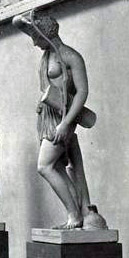
“Donations” (1863); NGV 1865, no.3; AR 1870-71, p.25 (6’2” high); NGV 1880, p.4; AR 1908: lent to Exhibition Trustees; cf.Brucciani (1870?), p.7 (6’6” high).
[photo: detail of Melbourne casts photo by Nettleton, 1872 (SLV H96.160/1790)]
For Howey (as for all individual donors noted), see Casts – Donors. AR 1870-71, identifying the source as the Amazon in the Vatican (as after Polyclitus), cites Pliny the Elder’s account of the five bronze statues of Amazons made for the Temple of Diana at Ephesus in the 4th century BC, and the decision (as voted by the sculptors themselves) that the statue by Polyclitus was the best, followed by that of Phidias. Modern scholarship indicates that the Vatican statue, known as the “Mattei Amazon,” probably reflects the Phidias original, and that other variants (e.g. the Roman copy in the Metropolitan Museum) copied Polyclitus’ figure; see https://en.wikipedia.org/wiki/Amazon_statue_types (accessed 10 August 2020).
Melbourne’s cast is recognizable in the left middle-ground of the engraving of the cast collection published in 1863, and in subsequent photos (including the 1872 view from which a detail is reproduced here). It was listed as surplus to the NGV’s requirements in “Municipal Statuary” (1908), and noted in AR 1908 as one of the casts lent to the Trustees of the Exhibition Building.
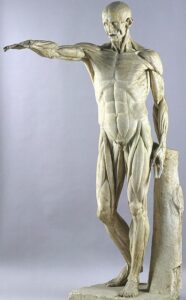
NGV 1865, no.4; AR 1870-71, p.36; NGV 1880, p.5; NGV 1894, VIII.113; cf.Brucciani (1891), p.4 (no.2392)
[photo: version shown in Houdon exh., Washington 2003]
French neoclassical sculptor Jean-Antoine Houdon (1741-1828), noted for his portrait sculptures of Voltaire, George Washington and other contemporaries, is identified in NGV 1865 as the artist responsible for the original statue, presumably his famous “flayed man” (Écorché) of 1767. This figure exists in several bronze and plaster versions and replicas, and is still often reproduced, at full or reduced scale.
I.8 Anatomical Figure {presented by the Education Dept., Melbourne, by 1894}
NGV 1894, VIII.104 (details as above)
NGV 1894 lists this cast separately from the previous entry, but it may have been another copy after Houdon. For other casts recorded as donated by the Education Department, see II.4 etc.
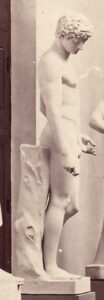
NGV 1865, no.5; AR 1870-71, p.36 (6’6″ high; original in the Capitol); NGV 1880, p.5; NGV 1894, VIII.94; cf.Brucciani (1858?), cat.8, & later eds.
[photo: Melbourne’s cast in view of c.1870 (SLV (H22789)]
This cast is clearly identifiable second from the left in an early view of Melbourne’s collection, as reproduced here. The original statue, in the Capitoline Museum, was found at Hadrian’s Villa in the early 18th century and acquired by Pope Clement XII. Traditionally identified as Antinous (the Greek youth idolized by the Emperor Hadrian), the figure is now described as a Roman copy of a 4th-century BC Hermes figure. There was also a cast in Sydney (AGNSW cat.1888, p.93). Melbourne’s copy was listed in AR 1909 as lent to the Trustees of the Exhibition Building.
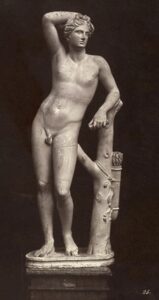
NGV 1865, no.8; AR 1870-71, p.37 (4’6” high); NGV 1880, p.5; NGV 1894, VIII.37; cf. Brucciani (1870?), p.7
[photo: Alinari photo of the Uffizi statue, taken c.1854]
Redmond Barry, in a letter of Nov.1860 to Hugh Childers, notes this cast (called “Youthful Apollo”) as one of the few from the first batch ordered to have escaped damage in transit (quoted by Galbally, “Lost museum” 1988, p.38). The Uffizi statue was documented in the Villa Medici in Rome in 1704, and then taken to Florence and restored in 1769-70. Widely praised in the 18th century as an echo of Praxiteles, the work lost admirers later (see Haskell & Penny 1981, cat.7); see also I.12. In AR 1908, Melbourne’s cast, identified as “Apollo (or the Lycian),” was listed as lent to the Trustees of the Exhibition Building.

Summers list 1861, no.1 (“Arms, legs, drapery – broken”); NGV 1865, no.6; AR 1870-71, p.36 (7’2” high); NGV 1880, p.6; NGV 1894, VIII.85; cf.Brucciani (1858?), cat.6, & later editions
[photo: detail of Melbourne’s cast from SLV H22789, c.1870]
The famous Vatican statue, already in the Belvedere by 1511, was widely praised and copied from the outset: see Haskell & Penny (1981), cat.8. It is now generally agreed to be a Roman work from the Hadrianic period (117 to 138 AD), after a 4th century BC original. Melbourne’s cast is clearly visible in overviews of Melbourne’s casts: see e.g.detail shown here. There was also a cast in Sydney (AGNSW cat.1888, p.93). See also II.5 (bust).
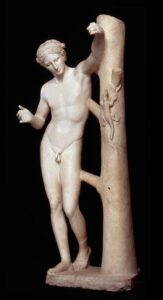
NGV 1865, no.7; AR 1870-71, p.37 ((5’1” high); NGV 1880, p.7; NGV 1894, VIII.102; cf.Brucciani (1870?), p.7 (?) & (1891), p.5 (no.2626)
[photo: Louvre statue]
Napoleon acquired the marble statue now in the Louvre (showing young Apollo as a “lizard killer”), together with other antiquities from the Borghese collection, in 1807. It is seen as the best Roman copy of a bronze by Praxiteles, as described in Pliny’s Natural History: see Haskell & Penny 1981, cat.9. A fragmentary bronze version, which surfaced in Germany in 2003, was purchased by the Cleveland Museum of Art in 2004 and claimed to be the missing original; however, its inclusion in a Praxiteles exhibition at the Louvre in 2007 led to controversy regarding its date, authenticity and provenance: see https://en.wikipedia.org/wiki/Cleveland_Apollo (accessed 14 Sept.2020).
In AR 1909, Melbourne’s cast was listed as one of several lent to the Trustees of the Exhibition Building.
I.13 Ariadne {presented by George James, Esq., by 1865}
“Donations” (1863); NGV 1865, no.9; AR 1870-71, p.25 (4’10” high); NGV 1880, p.11; NGV 1894, VIII.11; cf.Brucciani (1858?), cat.80, and Brucciani (1870?), p.7 (5’ high; describing the source as in the British Museum)
NGV 1880 and 1894 both identify the original as in the British Museum (see also Brucciani 1870?); but nothing currently in the London museum seems to correspond, and it is hard to find an alternative among the casts visible in the engravings and photographs of the Melbourne collection (although an unidentified figure second from the left in Charles Rudd’s 1886-7 view of the Melbourne casts may be relevant: see Casts – Overviews, no.9). At this stage it must remain unidentified, pending further information. In AR 1908, it was listed among a group of casts lent to the Trustees of the Melbourne Exhibition Building.
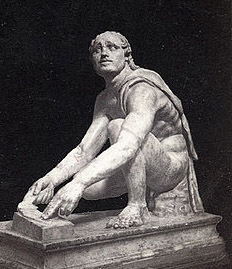
Summers list 1861, no.6; NGV 1865, no.56; AR 1870-71, p.41 (3’ high; also called “the Spy”); NGV 1880, p.21; NGV 1894, VIII.19; cf.Brucciani (1870?), p.8, & Brucciani (1891), p.5
[photo: Uffizi statue]
The late Hellenistic source, first recorded in Rome in the 1530s, and later acquired by the Medici, is in the Uffizi. Haskell & Penny (1981), cat.no.11, indicate that the work was widely admired and often copied, also noting that its original subject was often embroidered with dramatic stories to the effect that the man was listening to a plot; the name Arrotino simply means knife grinder, suggesting that the figure may have been intended to represent an assistant preparing for Apollo’s flaying of Marsyas. There was also a cast of this statue in Sydney (AGNSW cat.1888, p.93).
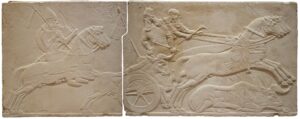
SB p.6 (3 slabs; £25); AR 1870-71, p.43; NGV 1880, p.34; NGV 1894, VIII.20; cf.Brucciani (1905), p.7
[photo: one of the extant casts at RMIT University (no.1895.5)]
The extraordinary Nimrud frieze, dating from the period of Assyrian King Ashurnasirpal II (883-858 BC), entered the British Museum collection in the 1840s and early 50s, following major excavations carried out in the northern part of what is now Iraq, by Sir Austen Henry Layard (1817-94). Ann Galbally (“Lost Museum,” 1988, p.37) quotes a comment in a letter of 26 October 1860, to Sir Redmond Barry, from his London agent R.E.Chester Waters: “I propose as soon as Layard is in town to ask him to select for you, two or three of the Lycian and Asyrrian bas reliefs. This will fill up one gap on the list.” The NGV stock-book lists three slabs, although only two are listed in NGV 1880 and 1894, both apparently extant, in the RMIT University Art Collection (1894.4 & 5), each over 2 metres wide. They show King Ashurnasirpal engaged in a bull hunt (for the originals, refer British Museum catalogue, nos.124534 and 124532 respectively, noted as excavated by Layard in 1846); see also Galbally, First Collections (1992), cat.69.
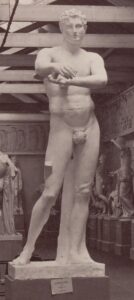
AR 1871, p.41 (as bought on the advice of Charles Summers); NGV 1880, p.7 (6’4” high); NGV 1894, VIII.68; cf.Brucciani (1891), p.4 (no.2544)
[photo: detail of overview of Melbourne’s casts by Nettleton,1872 (SLV H96.160/1790)]
Melbourne’s cast features prominently in one of Nettleton’s overviews of the collection, apparently taken soon after this cast was acquired: detail reproduced here. The reference to its purchase in the Annual Report for 1871 includes a note, possibly quoting Summer’s detailed advice, on the original as “one of the most perfect of Ancient Statues, only some of the fingers of the right hand and a small portion of the nose being imperfect. These portions have been restored by the late Professor Tenerani.” The Vatican statue was excavated in Trastevere in 1849 and recognized as a copy of the lost bronze statue by Lysippos, made in c.330 BC, and known through Pliny the Elder’s description of the athlete removing dust and sweat from his body (hence the Greek title, meaning ‘The Scraper’).
I.17 Bacchante (Bienaimé) {by 1870}
Not listed in in NGV 1865; AR 1870-71, p.37 (as after a sculpture by Pradier); NGV 1880, p.7 (2’6” high; after Pradier); NGV 1894, VII.50 (after Pradier); cf.Brucciani (1858?), cat.21 (Bienaimé), and cat.65 & 67 (Pradier)
[photo: Melbourne’s cast in photo of 1886-87 by Charles Rudd (NGV)]
This cast is clearly visible in the background of Rudd’s 1880s photo of the Melbourne cast collection (see Casts – Overviews, no.9): detail reproduced here. According to all the early Melbourne references, it reproduced a statue by Swiss-born James Pradier (1790-1852), who studied first in Rome and then with Ingres. Pradier created a sensation with his suggestive Satyr and Bacchante at the 1834 Paris Salon (now in the Louvre); but his earlier Reclining Bacchante (Musée des Beaux-Arts, Rouen, 1819) was a more restrained single figure, looking back over her shoulder. However, Melbourne’s cast was actually based on a different Reclining Bacchante, lounging on a lion skin, cup in hand, documented as the work of Italian sculptor Luigi Bienaimé (1795-1878), dated to c.1838 and in the Hermitage Museum, St Petersburg; for a photo, see e.g. https://commons.wikimedia.org/wiki/File:Luigi-Bienaim%C3%A9-Reclining_Bacchante-Hermitage.jpg (accessed 28 Sept.2020). Brucciani, who sold casts of Pradier’s figure (see e.g. Brucciani 1858?, cat.65 & 67), also supplied a cast of Bienaimé’s statue (ibid., cat.21), and it seems the two may have become confused in Melbourne’s order.
In 1908, this cast (described as “very ideal”) was identified in the Melbourne Age as no longer required by the NGV, and noted in AR 1908 as lent to the Exhibition Trustees.
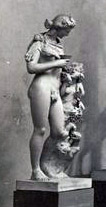
“Donations” (1863); NGV 1865, no.11; AR 1870-71, p.25 (4’10” high); NGV 1880, p.7; NGV 1894, VIII.10
[photo: Melbourne’s cast as shown in photo by Nettleton, 1872 (SLV H96.160/1789)]
This cast is identified in AR 1870-71 as based on a British Museum original. The Roman group, found in 1771, was acquired with the Townley collection in 1805: see British Museum online catalogue. NGV 1894 explains that “Ampelus, [Bacchus’] companion, a Phrygian youth, was thrown from the back of a bull and killed. His body was changed into a vine.” Another version of the myth says the youth fell from a vine.
In “Municipal Statuary” (1908), Melbourne’s cast was listed among those surplus to the NGV’s requirements.
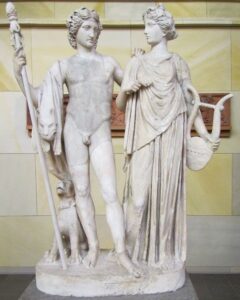
AR 1870-71, p.37 (no details provided); NGV 1880, p.8 (as 4’4” high); NGV 1894, VIII.15; cf.Brucciani (1870?), p.7 (as from a group in the Capitol, 4’9” high)
[photo: group in Berlin]
This cast, catalogued in NGV 1880 as 4’4” (about 1.3 m) high, is hard to identify. Brucciani (1870?) listed a cast of similar size, identifying the source as a statue in the Capitol (where no such group is now recorded). A heavily restored group in the Berlin Antikensammlung, reproduced here, may have been the source, but there are also 18th-century bronzes by Corneille van Cleve (Washington) and Giuseppe Piamontini (Getty Museum). Further research may prove productive.
In 1908, Melbourne’s cast was one of those listed in the Melbourne Age as no longer required by the NGV, and noted in AR 1908 as lent to the Exhibition Trustees.
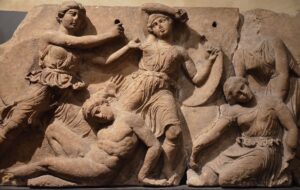
SB p.6 (£30); AR 1870-71, p.43; NGV 1880, p.34: 22 slab; NGV 1894, VIII.70
[photo: one of the original reliefs (BM 1815.1020.23)]
The relief frieze which decorated the interior of the cella of the Temple of Apollo in Bassae (in the Greek Peloponnese) was bought at auction for the British Museum in 1815. In 23 slabs, 0.63 m high, and slightly over 30 metres in overall length, the reliefs, dated to c.420-400 BC, depict Greeks fighting centaurs and Amazons (as in the panel reproduced here). Melbourne’s casts, part of the initial order from Brucciani (see Galbally, “Lost museum,” 1988, p.37), are visible in several early views of the collection, installed opposite the Parthenon frieze (I.90).
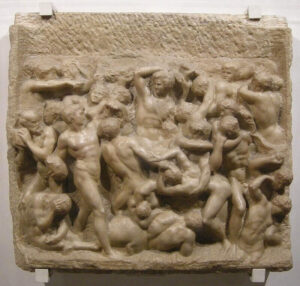
AR 1870-71, p.43; NGV 1880, p.33; NGV 1894, VII.80
[photo: original relief in Florence]
Melbourne’s cast, described rather obscurely in AR 1870-71 as “Battaglia di Ballego” (or “Ballejo,” in NGV 1894), almost certainly reproduced Michelangelo’s precocious early relief known as Battle of the Centaurs (Casa Buonarroti, Florence, c.1492). It may have been one of the “3 slabs by Michelangelo” referred to in a letter of Oct.1860 from Hugh Childers to Redmond Barry, as part of Melbourne’s first order of casts from Brucciani). For other pre-Felton casts by or attributed to Michelangelo, see linked entry.
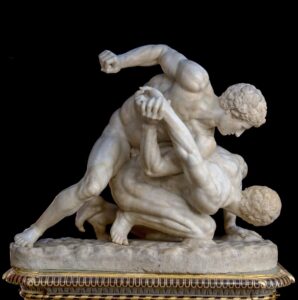
Summers list 1861, no.3; NGV 1865, no.12; AR 1870-71, p.37 (3’ high); NGV 1880, p.8; NGV 1894, VIII.95; cf.Brucciani (1870?), p.7
[photo: Uffizi group]
The Uffizi sculpture was discovered in 1583, with the Niobe group (see II.25), to which it was once thought to belong (thus in AR 1870-71 and NGV 1894); for further details, see Haskell & Penny 1981, cat.94 (Wrestlers), noting that the statue is now seen as a copy of a Hellenistic original. Older commentary (as in AR 1870-71) focused mainly on whether the two men are boxers or wrestlers; the latter does seem more likely, at least in terms of the Queensberry rules, drafted in London in 1865, and published in 1867: see https://en.wikipedia.org/wiki/Marquess_of_Queensberry_Rules (accessed 15 Sept.2020). Melbourne’s cast is partially visible at the extreme left of the photo of the cast collection published in NGV 1905.
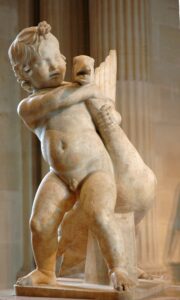
NGV 1865, no.14 (details as below); AR 1870-71, p.37 (2’9” high); not listed in NGV 1880 or 1894
[photo: Capitoline statue]
This cast is listed in NGV 1865 and AR 1870-71, identifying the source as a work found in 1789, and now in the Capitol, regarded as a Roman copy of a statue described by Pliny the Elder as by a sculptor named Boethus (2nd century BC?). There are other marble versions in Munich and the Louvre.
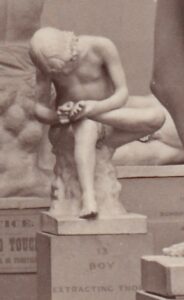
NGV 1865, no.13; AR 1870-71, p.37 (2’4” high; original noted as in the Villa Albani, Rome; also mentioning a “repetition” in the Uffizi); NGV 1880, p.7 (original as either in the Villa Albani or the Pitti {sic}); NGV 1894, VIII.80 (see below); cf.Brucciani (1858?), cat.17 (citing a Vatican original), and later editions
[photo: detail of overview of Melbourne’s casts, 1880s-90s? (SLV H11790)]
The source of this cast, clearly recognizable in several views of the collection, is identified variously in the early NGV references, as detailed above, but NGV 1894 confidently and it would seem correctly identifies it as based on “the original bronze, attributed to Pasiteles,… in the Capitol, Rome,” and usually called “Spinario” (Pasiteles was a 1st-century BC sculptor mentioned by Pliny). The Capitoline figure, generally regarded as a Roman sculpture combining a Hellenistic prototype with a head modelled on an earlier Greek statue, was first mentioned in the 12th century, and was on the Capitol by the late 15th century; it was frequently copied and adapted, notably by Brunelleschi (for details, see Haskell & Penny 1981, cat.78; see also Grove Art Online ‘Spinario’ article by L.Leoncini & T.Opper [2003/2011]). Other variants include another bronze in the Vatican (the basis for a cast sold by Brucciani); a marble version in the Uffizi (probably the version best known to Florentine Renaissance artists); and a somewhat different marble variant acquired by the British Museum in 1880 (the “Castellani Spinario”), arguably the most faithful reflection of the original Hellenistic figure. The Sydney gallery also owned a Spinario cast (AGNSW cat.1888, p.93).
Melbourne’s cast was listed in AR 1909 as one of several lent to the Trustees of the Exhibition Building.
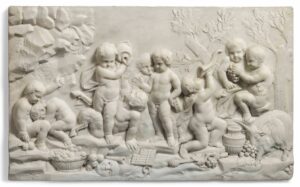
Summers list 1861, no.26; AR 1870-71, p.43 ( “Casts of Friezes”); NGV 1880, p.33; NGV 1894, VII.103; AR 1900, p.31, noting the loan of these casts to the Working Men’s College, Melbourne (now RMIT University)
[photo: marble relief auctioned in 2003]
The NGV sources cited above list these as casts of reliefs of “Boys” by “Fiamingo,” NGV 1880 giving the artist’s date of death as 1709, and the 1894 catalogue indicating that he was also known as “Hubert Longe.” Despite these obscure details, the artist involved was almost certainly Dutch Baroque sculptor François Duquesnoy (1597-1643), who worked mainly in Rome (and was known in Italy as Il Fiammingo), and the casts were probably based on marble reliefs of revelling putti for which Duquesnoy was known; see for example the work reproduced here, auctioned in Paris in 2003: refer https://www.christies.com/lotfinder/Lot/a-marble-relief-of-a-bacchanalian-scene-5855712-details.aspx (accessed 23 August 2020).
NB a further group of 6 smaller “fictile ivory” (plaster) reliefs, also of “boys,” by the same artist, also listed in AR 1870-71 and NGV 1880, was probably based on a set of 6 Bacchanalian ivory reliefs by or after Duquesnoy in the V&A Museum (1059 to 1064-1853): details yet to be added under replicas of Decorative Arts. For Duquesnoy, see also I.33 below.
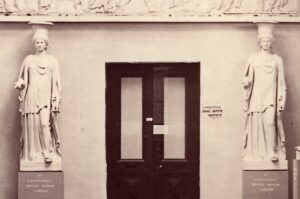
“Donations” (1863), listing the cast donated by Mrs Barry; NGV 1865, no.16 (both statues); AR 1870-71, p.25 (as 7’4” high; with donor details as shown above); NGV 1880, p.8; NGV 1894, VIII.5 & 6; cf.Brucciani (1905), p.27
[photo: the two casts as visible in the early photo of the Melbourne collection, c.1870 (SLV H22789)]
Melbourne’s casts, visible in several early overviews, were both based on the same original, the so-called “Townley Caryatid” (“canephora” is an older term), found near the Via Appia in 1766, and now dated to c.140-160 AD, though previously thought to be Greek. Charles Townley acquired the statue (one of six originally decorating a small temple) in 1787, and it was part of his bequest to the British Museum in 1805.
The cast donated by Sir Redmond Barry’s mother is listed in 1863, but the second cast may have arrived slightly later; both are listed in NGV 1865: see Casts – Donors.
I.28 Castor and Pollux {by 1865}
NGV 1865, no.17; AR 1870-71, p.32 (4’11” high); NGV 1880, p.9; NGV 1894, VIII.34; cf.Brucciani (1870?), p.7 (5’6” high: Vatican original)
[photo: group in the Prado]
Both NGV 1894 and Brucciani (1870?) refer to the source as a statue in the Vatican, but Melbourne’s cast, visible in several early overviews of the collection (e.g. SLV H11790) clearly reproduces a 1st-century AD Roman group now in the Prado, first documented in the Ludovosi collection in Rome in 1626, and sold to Philip V of Spain in 1724. While it was in the Ludovisi collection, a Hadrianic head of Antinous was added to the left-hand figure, and the group became known as “Antinous and Hadrian’s Genius” (evidently the basis for a cast shown in the Greek Court of the Crystal Palace in 1854, cat.76). For the later history of the Prado group, see Haskell & Penny, cat.19, and https://en.wikipedia.org/wiki/Castor_and_Pollux_(Prado).
In 1908, Melbourne’s cast was another of those listed in the Age (“Municipal Statuary”) as no longer required, and also noted in AR 1908 as lent to the Exhibition Trustees.
I.29 Ceres and Proserpine {c.1860}
Summers list 1861, no.13
The damage to this cast suffered in transit from England appears to have been irreparable, as it is not listed in NGV 1865, 1880 or 1894. It is very difficult to be certain of the source, as no antique groups now known by this name seem to correspond. It may have reproduced an 1843 marble group by Ludwig Schwanthaler in the Alte Nationalgalerie, Berlin, but this is far from certain.
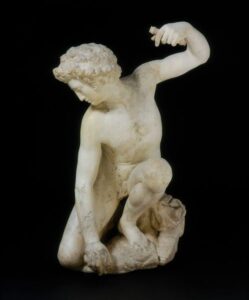
NGV 1865, no.20; AR 1870-71, p.33 (3’ high); NGV 1880, p.9 (details as noted above); NGV 1894, VIII.88; cf.Brucciani (1891), p.4 (no.2268)
[photo: statue in the V&A (no.7560-1861)]
Discovered in Florence and acquired for the V&A in 1861, the statue reproduced here was initially celebrated as the Cupid, previously thought lost, carved all’antica by the young Michelangelo, by 1496: both the 1880 and 1894 NGV catalogues reflect this view. However, the V&A figure is now identified as a Narcissus of c.1560, and seen as substantially the work of the Florentine sculptor Valerio Cioli (c.1529-99), well known as a restorer of classical sculptures, one of which may have served as the basis for this figure; the raised arm is a 19th-century addition.
A more recent, seemingly even less plausible candidate for the lost Michelangelo is a fragmentary marble figure known as the “Manhattan Cupid,” previously in Rome, later housed in a Fifth Avenue mansion owned by the French Government, and on loan to the Metropolitan Museum until recently. It should be observed that the 16th-century documentation for Michelangelo’s Cupid (comprising correspondence by the artist and others, as well as later reports by Condivi and Vasari) indicates that it was a bambino, recumbent and asleep, and hence unlike either of the later candidates mentioned above (see now Michael Hirst, Michelangelo, Volume I: The Achievement of Fame 1475-1534, Yale UP, 2011, pp.27-29).
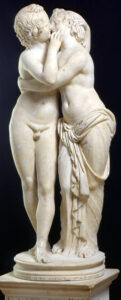
NGV 1865, no.19; AR 1870-71, p.37 (4’1” high); NGV 1880, p.9; NGV 1894, VIII.38; cf.Brucciani (1870?), p.7 (4’9” high)
[photo: Capitoline group]
The marble group, in the Capitoline Museum since its discovery in 1749 (apart from a period in France between 1797 and 1816), was admired from the outset for the tenderness of the figures’ embrace. Modern scholarship identifies it as a Roman copy of a 2nd– or 1st-century BC Hellenistic original (see Haskell & Penny 1981, cat.26).
Melbourne’s cast, visible in several early views of the collection, was the same height as the original (1.25 metres). In AR 1908, it was listed among casts lent to the Exhibition Building.
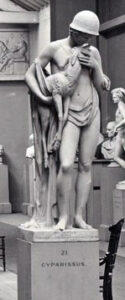
SB p.1 (including valuation of £5/5/-); NGV 1865, no.21; AR 1870-71, p.25 (as 4’8” high; quoting Ovid); NGV 1880, p.9; NGV 1894, VIII.30; cf.Brucciani (1870?), p.7 (5’3” high)
[photo: Melbourne’s cast as shown in general view of the collection, 1880s-90s (SLV H11790)]
This cast is identifiable in several early photographs of the Melbourne collection, notably SLV H11790, where it appears prominently in the foreground, with identifying title and catalogue no.: detail shown here. In AR 1906, it was noted as lent to the Sale School of Mines.
In the chronology of casts published in NGV 1865, p.28, and AR 1870-1, p.44, the original is described as “Antique, though of uncertain date,” and the view that the source was ancient seems to have persisted throughout the pre-Felton period. But in fact the original statue, in the Hermitage, St Petersburg, is a work of 1798, by French neoclassical artist Antoine-Denis Chaudet (1763-1810): see e.g. https://commons.wikimedia.org/wiki/File:Cyparissus.jpg (accessed 4 August 2020). The curious helmet-like hat also appears in another Chaudet statue (The young Oedipus brought back to life by the Shepherd Phorbas, Louvre, 1801). The Greek myth of Cyparissus, re-told by Ovid (Metamorphoses, book X), tells of the young man, loved by Apollo, who accidentally killed his pet deer while hunting, and, after begging to be able to grieve for eternity, was turned into a cypress tree by Apollo (the sap imitating the boy’s tears).
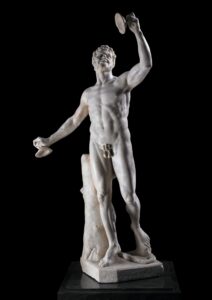
Summers list 1861, no.4 (presumably this cast); NGV 1865, no.34; AR 1870-71, p.39, describing the restorations as attributed to Michelangelo); NGV 1880, p.13 (5’8” high); NGV 1894, VIII.97; cf.Brucciani (1891), p.4
[photo: British Museum statue]
The marble figure on which Melbourne’s cast was based, the so-called Rondanini Faun, in England since 1826, is acknowledged in the 1870-71 annual report as largely re-worked (“the thorso {sic} is the only portion really antique”). The British Museum describes it as “extensively restored or ‘completed’ during the Baroque” by François Duquesnoy, c.1625-30 (for Duquesnoy, see I.25 above). For casts of other Dancing Fauns in the Melbourne collection, see entries following.
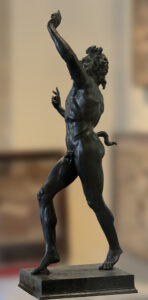
AR 1870-71, p.28 (Murphy gift, under “Casts of statues”); NGV 1894, VIII.99 or VIII.112 (both identified as copies of the Naples statuette)
[photo: bronze statue in Naples, Museo archeologico]
The 1894 NGV catalogue lists no fewer than three copies of the famous bronze faun in Naples (measuring 71 cm high): a bronze replica – see Unknown (Italian 19C) Dancing Faun {1892} NGV [SC] – and two plaster casts, one presumably the one listed here; see also next entry. The Naples statue, found at Pompeii in 1830, is presumed to be a Roman copy of a Hellenistic original: see Haskell & Penny 1981, cat.35. One of Melbourne’s two plaster casts is visible to the left in the overview of the collection published in NGV 1905. For the casts acquired through Murphy’s 1862 donation, see Casts – III.Miscellaneous (i), and Casts – Donors.
I.35 Dancing Faun [Naples] (c.2) {1892}
AR 1892, p.2; NGV 1894, VIII.99 or VIII.112
See previous entry.
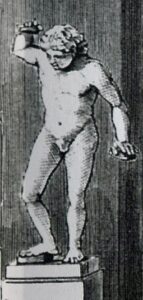
NGV 1865, no.33; AR 1870-71, p.39 (4’6” high); NGV 1880, p.13; NGV 1894, VIII.107; cf.Brucciani (1870?), p.8 etc.
[photo: detail of wood engraving of the MPL Sculpture Gallery published in The Illustrated Melbourne Post, 27 July 1866 (SLV)]
For the Uffizi statue, a Roman copy of a Greek original, see Haskell & Penny (1981), cat.34. Both AR 1870-71 and NGV 1894 mention under restorations that the head and arms are by Michelangelo, a traditional idea now deemed unlikely, although Haskell & Penny comment that the additions are of high quality and probably 16th-century in date. Melbourne’s cast is recognizable in a number of the early views of the cast collection. The entry in AR 1870-71 notes “two copies,” but that may refer to this cast and I.33; only 1 cast of the present figure is listed in the various NGV catalogues cited above.
I.37 Dancing Girl, with wreath {presented by James Murphy, 1862}
AR 1870-71, p.28
Cast of an unidentified statue listed among the casts donated by Murphy to the Melbourne School of Design. See also * Gott Flora {1885} Loc? [SC].
I.38 Danish Coat of Arms {1884}
AR 1884, p.36: “Armorial Bearings of the Royal Arms of Denmark”
There do not appear to be any other references to this cast.
I.39 Dawn, Day, Dusk & Night (statuettes after Michelangelo) {1904}
AR 1904, p.25 (price given as £1/1/- each); cf.Brucciani (1891), p.5 (statuettes of all 4, same price)
As noted, Brucciani sold reduced-scale casts of the famous Medici Chapel figures. See also I.56 (cast of the statue of Giuliano de’Medici) and II.36: mask of Dawn.
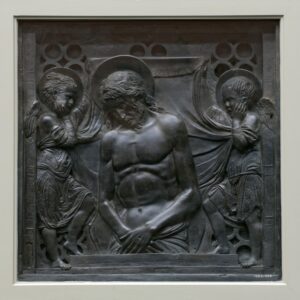
NGV 1894, VIII.86; see also AR 1870-71 as cited below
[photo: V&A cast, produced c.1884]
The 1894 NGV catalogue entry is the first certain mention of Melbourne’s cast, though it may have been the work referred to in an eccentric listing in AR 1870-71 (p.43, under “Casts of Friezes”) as “The Dead Apostle – Donatelli” {sic}. It probably reproduced Donatello’s bronze relief for the High Altar of Sant’Antonio, Padua (1447-50), also the basis for a painted plaster cast in the V&A (REPRO.1884-329), catalogued as made by Signor Tombola, Venice, c.1884: see photo shown here.
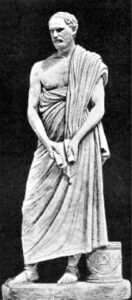
NGV 1865, no.22; AR 1870-71, p.26 (6’5″ high; noting Vatican original); NGV 1880, p.10; NGV 1894, VIII.27; cf.Brucciani (1891), p.5 (via a statue in Naples)
[photo: statue in the Museo Pio-Clementino, Vatican]
The source was evidently the statue reproduced here, thought to be based on the same Greek original by Polyeuktos as the British Museum bust of Demosthenes: see II.37. The famed Athenian orator (384-322 BC) spoke eloquently against both Phillip II and Alexander the Great.
Melbourne’s cast is fairly certainly identifiable as the figure fifth from the left in the engraving of the collection published in The Australian news for home readers, 27 July 1866 (see SLV copy). In 1908, the cast was listed in the Age as no longer required by the NGV, and noted in AR 1908 as lent to the Exhibition Trustees.
I.42 Diana (Benzoni) {presented by C.E.Labilliere, Esq., 1863}
NGV 1865, no.24; AR 1870-71, p.26 (as 4’10” high); NGV 1880, p.10; NGV 1894, VII.28
[photo: Melbourne’s cast as visible in Charles Rudd’s 1886-87 overview (NGV)]
NGV 1865 and the later Melbourne references note that this cast was based on an original by G.M.Benzoni (1809-73), but do not specify which particular example was involved. A statue in the Hermitage, which looks closely comparable with Melbourne’s cast, was apparently already in Russia in 1856: see now https://commons.wikimedia.org/wiki/File:Diana-Hermitage.jpg (accessed 28 Sept.2020). Typically, though, Benzoni and his workshop produced a number of variants, including one carved in 1859 and included in the London Exhibition of 1862 (now in the V&A), possibly a more accessible source. Benzoni’s Diana was inspired by the grand Greco-Roman statue in the Louvre: see next entry. (For marble statues by Benzoni formerly in the pre-Felton collection, see linked artist entry).
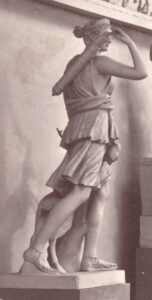
Summers list 1861, no.7 (“Hand broken off, arms and drapery broken”); NGV 1865, no.23; AR 1870-71, p.33 (6’5” high); NGV 1880, p.10; NGV 1894, VIII.13; AR 1900, p.31, noting the loan of this cast to the Working Men’s College, Melbourne (now RMIT); cf. Brucciani (1858?), cat.7, Brucciani (1870?), p.8
[photo: detail of Nettleton photo of Melbourne’s casts, 1872 (SLV H96.160/1789)]
For the Louvre original, a Roman copy of a presumed bronze of the 4th century BC, see Haskell & Penny 1981, cat.no.30. First certainly recorded at Fontainebleu in 1586, it was displayed in the Louvre Palace in the early 17th century, and then transferred to Versailles by Louis XIV; after the French Revolution, it was moved to Paris and displayed in the future Louvre museum. Melbourne’s cast is clearly visible in several early views of the collection. See also II.38 (mask, possibly based on this statue).

Summers list 1861, no.8; NGV 1865, no.25; AR 1870-71, p.33 (5’4” high); NGV 1880, p.11; NGV 1894, VIII.36; cf.Brucciani (1858?), cat.95, and later eds.
[photo: detail of NGV cast collection photo, 1880s-90s (SLV H11790)]
This cast reproduced the Louvre statue, excavated on Borghese property near Rome in 1792, and then purchased by Napoleon in 1807 with other antique statues from the Borghese collection. Widely admired and reproduced in the 19th century, it is regarded as a copy of an original by Praxiteles from the Temple of Artemis Brauronia on the Athens Acropolis (for details, see Haskell & Penny 1981, cat.31). Melbourne’s cast is recognizable in several early overviews of the collection. See also II.39, identified as a cast of the head of this figure.
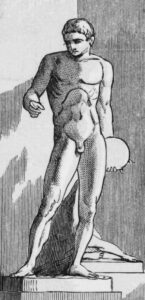
NGV 1865, no.26; AR 1870-71, p.38 ((5’6” high); NGV 1880, p.11; NGV 1894, VIII.47/48 (2 casts?); AR 1900, p.31: note of the loan of this cast to the Melbourne Working Men’s College (now RMIT); cf.Brucciani (1870?), p.8 (6’ high) & later eds.
[photo: detail of wood engraving in The Australian news for home readers, 27 July 1866 (SLV)]
This cast reproduced the Vatican statue of an athlete readying himself to throw the discus, excavated at Tivoli in 1771, and identified as a copy of a Greek statue of c.410-400 BC by Naukydes (as described by Pliny the Elder); there are other versions in the Louvre etc. The discovery shortly afterwards of several versions of the more famous Discobolus in mid-throw (see I.46) tended to eclipse the fame of the present figure. Melbourne’s cast appears in several of the early views of the collection, including the recognizable if not particularly flattering image reproduced here.
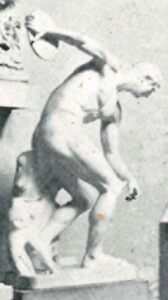
NGV 1865, no.27; NGV 1880, p.11 (5’2” high); NGV 1894, VIII.50/51 (2 casts?); cf.Brucciani (1858?), cat.9
[photo: detail of overview of Melbourne’s casts in NGV 1905]
Worryingly, both Napoleon and Hitler were fans of the best known version of this famous statue, discovered in Rome in 1781 (now in the Museo Nazionale Romano), and immediately recognized as a copy of the 5th-century BC Greek bronze by Myron, as described by classical writers. Other copies were found in 1791, including the Townley version in the British Museum, widely available in cast form despite criticism that its (added) head was wrongly turned, and clearly the source of Melbourne’s cast. For comments on the various statues involved, see Haskell & Penny 1981, cat.32. There was also a Discobolus cast in Sydney (AGNSW cat.1888, p.93). See also I.45.
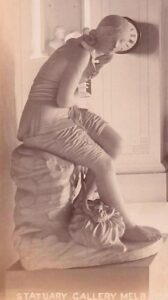
“Donations” (1863); NGV 1865, no.28; AR 1870-71, p.26 (3’11” high); NGV 1880, p.11; NGV 1894, VII.15
[photo: detail of photograph by Charles Rudd: Statuary Gallery, Melbourne Public Library, 1886-87 (NGV, gift of Terence Lane, 1990)]
This cast and I.86 were donated together by Moor and his wife (for details, see Casts – Donors).The original marble statue of Dorothea (one of Cervantes’ characters in Don Quixote) was commissioned by Lord Lansdowne from English sculptor John Bell (1811-95) in 1838. The work proved popular, with reduced-scale Parian porcelain copies produced by Minton from 1847 onwards: an example from 1861 is held in the NGV (presented by Dr Robert Wilson, 2001). Bell also carved the “America” group for the Albert Memorial, and various other works. For the photograph containing the detail reproduced here, see NGV PH6-1990. In AR 1906, this cast was noted as lent to the Sale School of Mines, which may point to its subsequent history.
I.48 Entry of Cosmo {sic} de Medici into Florence (Michelangelo?) {by 1870}
AR 1870-71, p.43; NGV 1880, p.33; NGV VII.96
Given Michelangelo’s complicated relationship with the Medici especially after 1530, and his republican sympathies, it seems inherently unlikely that this cast was based on a work by him; nor, to my knowledge, is there any mention of Michelangelo or anyone else depicting Cosimo the Elder’s return from exile in 1434. Perhaps the work on which this cast was based formed part of the propaganda generated at the time of the artist’s 1564 funeral in Florence, to imply a less antagonistic relationship than actually existed between him and Cosimo I (Duke/Grand-Duke 1537-69): see now R.& M.Wittkower (ed.), The Divine Michelangelo: the Florentine Academy’s Homage on His Death in 1564, Phaidon, 1964.
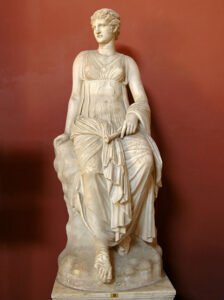
NGV 1865, no.30; AR 1870-71, p.38 (4’6” high; noting Vatican original); NGV 1880, p.12; NGV 1894, VIII.7; cf.Brucciani (1870?), p.8 (via another Euterpe, in the Louvre)
[photo: Vatican statue]
This cast (not recognizable in early photographs and engravings of the collection) was presumably based on the statue in the Vatican’s Pio-Clementine Museum, now regarded as a copy of a Hellenistic figure, with a head added from another source: see photo. For another image of Euterpe, the Muse of Lyric Poetry, see * Benzoni Euterpe {1885} Loc? [SC], and for casts of other Muses, see also I.93 and I.100.
In 1908, Melbourne’s cast was listed as no longer required by the NGV – see “Municipal Statuary” (1908) – and also noted among a group of casts lent to the Trustees of the Exhibition Building (AR 1908).
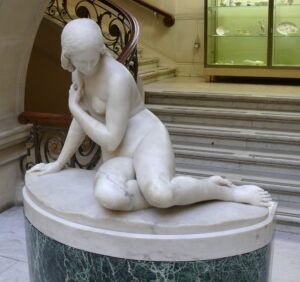
NGV 1865, no.29; AR 1870-71, p.38 (as 2’7” high); NGV 1880, p.12; NGV 1894, VII.58; AR 1900, p.31: note of the loan of this cast to the Melbourne Working Men’s College (now RMIT); cf.Brucciani (1858?), cat.20 & Brucciani (1870?), p.14
[photo: original statue in the Bristol Museum]
Edward Baily (1788-1867), a native of Bristol, carved his famous Eve in 1822; she stares at her reflection, as suggested by a line in Milton’s Paradise Lost (the relevant passage is quoted in the 1870-71 Annual Report). Baily’s best known work was the statue of Nelson atop Nelson’s Column (c.1843); for other Melbourne casts after his work, see I.78 and II.20.
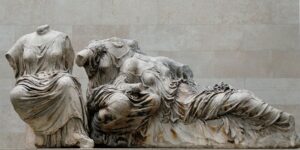
SB p.2 (£25); NGV 1865, no.32; AR 1870-71, p.39 (heights listed as 3’11” and 4’5” respectively); NGV 1880, p.13; NGV 1894, VIII.1; cf.Brucciani (1891), p.4 & Brucciani (1905), p.19 (ill.)
[photo: the original statues in the British Museum]
One of several casts purchased for Melbourne in the early 1860s after the Parthenon sculptures in London (the so-called Elgin Marbles), traditionally ascribed to Phidias, c.447-432 BC. For more extended comments on Melbourne’s Parthenon casts as a group, see I.90 (on the frieze); see also I.69, I.72, I.91 and I.101. The present group, variously identified as Fates or goddesses, was sold by Brucciani in two plaster sections, priced at £7 and £18 respectively. It is unclear from most of the overviews of the Melbourne cast collection how they were exhibited, but in one photo, c.1880s-90s (SLV H4578) the two casts seem to be shown opposite one another at the back of the room.
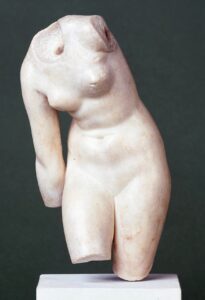
AR 1884, p.36 (quoted below); not listed in NGV 1894; cf.Brucciani (1891), p.3 (no.455: as via a British Museum statue)
[photo: British Museum figure]
The NGV’s Annual Report for 1884 notes the acquisition of a cast of a “small Female Torso, from the original in the Townley Gallery, British Museum,” presumably based on the fragmentary Roman statuette of Venus bought in Rome by Townley in 1770 (BM 1805,0703.17). See also I.103 & 104.
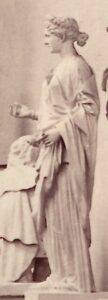
NGV 1865, no.31; AR 1870-71, p.39 (as via the statue in the Capitol, found at Tivoli in 1744); NGV 1880, p.13 (5’3” high); NGV 1894, VII.61; cf.Brucciani (1870?), p.8 and Brucciani (1891), p.4
[photo: Melbourne’s cast in a photo of the collection, c.1870 (SLV 22789)]
In the Capitoline collection since its discovery (apart from a period in Paris, 1798-1815), this statue was often admired and copied: see Haskell & Penny 1981, cat.no.40 (as Roman, but with later additions). Winckelmann and others raised doubts about the identification as Flora; other suggestions include Hadrian’s wife Sabina, or Juno. Melbourne’s cast was listed in AR 1908 as one of several lent to the Exhibition Trustees in that year.
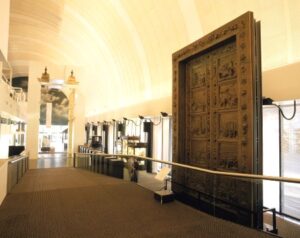
Summers report 1861, no.25 (“Panel from Ghiberti Gate… Smashed”); AR 1870-71, p.43 (Sacrifice of Abraham, Sacrifice of Noah); NGV 1880, pp.33-34 (all 3 panels); NGV 1894, VIII.43-45; cf.Brucciani (1870?), p.39 (4 panels); see also Brucciani (1891), pp.21-22 (listing several panels and details)
[photo: cast of the Ghiberti doors in the Powerhouse Museum, Sydney]
These casts reproduced narrative panels from the famous bronze doors by Lorenzo Ghiberti (1378-1455), his second set for the Florence Baptistery (1425-52). Brucciani & Co. sold casts of panels, and individual figures. Melbourne’s casts were of the panels depicting the Creation of Adam and Eve, the Sacrifice of Noah and the Sacrifice of Abraham (the last two definitely in the collection in the early 1860s, the Adam & Eve panel possibly added later). Several full-scale reproductions of the complete doors are extant, including an electrotyped gilt copy in the V&A Museum (produced in 1867). In 1890, Sir James Fairfax donated a complete plaster copy, painted brown to simulate bronze, to the Art Gallery of New South Wales: see comparative photo reproduced here. The AGNSW catalogue (rev.ed.1919, p.172) noted that “the State may be congratulated on having obtained a model of these famous gates,… the Italian Government having refused to allow any more models to be taken” (after concerns that the original gold leaf was being lifted by the taking of casts).
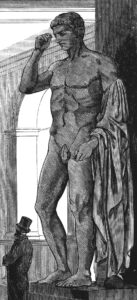
NGV 1865, no.32 (as Gemanicus, also known as Mercury); AR 1870-71, p.39 (5’11” high); NGV 1880, p.14; VIII 1894, VIII.75; AR 1900, p.31: note of the loan of this cast to the Melbourne Working Men’s College (now RMIT); cf.Brucciani (1870?), p.8 etc.
[photo: detail from engraving of Melbourne’s casts, Illustrated Melbourne Post, 27 July 1866 (SLV)]
First recorded in Rome in the mid 16th century, the statue now in the Louvre was sold to Louis XIV in 1685-6: see Haskell & Penny (1981), cat.42, noting identifications of it as Germanicus (15 BC – 19 AD, a noted general who was the brother of the Emperor Claudius), or the Emperor Augustus. The Louvre now catalogues it as a funerary image of Octavius’ nephew Marcellus, who died young in 23 BC, made in about 20BC, but referencing an ancient Greek Hermes type. Melbourne’s cast is prominent in various early views of the collection.
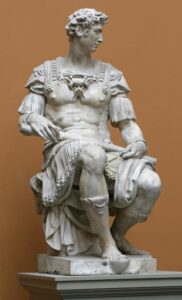
“Donations” (1863) (as Lorenzo de’Medici); NGV 1865, no.45; AR 1870-71, p.26 (5’7” high); NGV 1880, p.17; NGV 1894, VIII.105
[photo: V&A cast, c.1881]
This cast (identified, incorrectly, as “Lorenzo de’Medici” in 1863, and then called “Julian de Medici” in the other early NGV sources) reproduced one of the two statues of Medici Dukes in the New Sacristy of the church of S.Lorenzo. Giuliano (1479-1516), the third son of Lorenzo “il Magnifico,” and the brother of Pope Leo X, ruled Florence after the reinstatement of the Medici in 1512, until his premature death, when he was succeeded by his nephew Lorenzo (1492-1519), the other Medici Chapel Duke. The major sculptural work on both tombs dates from the 1520s and was left unfinished when Michelangelo left Florence permanently in 1534. Giuliano sits above the recumbent figures of Night and Day (see also I.39). This cast is prominent in several early photographs of the Melbourne collection, notably the overview published in NGV 1905. A later 19th-century cast credited to Oronzio Lelli is extant in the V&A Museum: reproduced here.
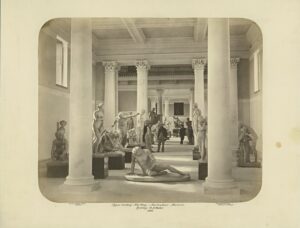
NGV 1865, no.36; AR 1870-71, p.39 (2’8” high); NGV 1880, p.14; NGV 1894, VIII.91
[photo: Cast Gallery, Sydney: photo by William Hetzer, 1866 (SLV H15179)]
The source was the statue in the Capitoline Museum, Rome, first documented in the Ludovisi collection in 1623, and then acquired by Pope Clement XII (1730-40): see Haskell & Penny 1981, cat.44. Now generally regarded as showing a defeated Gaul, it is taken to be a Roman copy of a Greek bronze of the 3rd century BC (when the Gauls attacked Delphi). Often copied and reproduced, the figure was admired particularly for its embodiment of pathos (as noted e.g. by Byron in Childe Harold, lines quoted in AR 1870-71 and NGV 1880). Another cast was held in Sydney (see AGNSW catalogue, 1888, p.174); for a photo of the Sydney cast collection dated to 1866, with this figure displayed in the foreground, see reproduction above.
I.58 Gladiator, Fighting {presented by James Murphy, Esq., 1862}
Summers list 1861, no.9 (“hand and arm broken”); NGV 1865, no.37; AR 1870-71, p.28 (casts donated by Murphy) and p.39 (casts purchased; as 5’ high); NGV 1880, p.15 (cast donated by Murphy); NGV 1894, VIII.108 (cast donated by Murphy); cf.Brucciani (1905), p.3 (no.1614)
[photo: detail from overview of the Melbourne cast collection, 1880s-90s (SLV H4578)]
This cast reproduced the statue in the Louvre; in the Villa Borghese by 1613, it was purchased by Napoleon, with other Borghese antiquities, in 1807: see Haskell & Penny 1891, cat.43 (Borghese Gladiator). The statue, signed by Agasias of Ephesus, was sometimes identified as a heroic figure such as Achilles or Hector. According to the Louvre, it is a Hellenistic “fighting warrior” of c.100 BC, adapting an original by Lysippos.
NB two separate casts of this statue were acquired for the Melbourne collection in the early 1860s, one purchased with the original group of casts in 1860, and the second acquired as part of the donation by James Murphy in 1862 (both are listed in AR 1870-71). But only one cast is listed in the NGV catalogues issued from 1865, and that is specified in both NGV 1880 and NGV 1894 as the one donated by Murphy. Perhaps the damage noted by Charles Summers in 1861 was too severe to repair, and Murphy’s cast was preferred (or chosen as a replacement). There was also a cast in Sydney (see AGNSW cat.1888, p.93, and the 1866 photo of the Sydney collection reproduced above, under cast I.57).
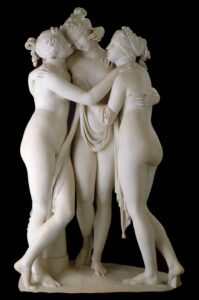
Summers list 1861, no.15 (“heel broken”); NGV 1865, no.38; AR 1870-71, p.40 (5’2” high; “original in the collection of the Duke of Bedford (?)”); NGV 1880, p.15; NGV 1894, VII.64; cf.Brucciani (1858?), cat.no.4
[photo: V&A/Edinburgh statue]
This cast apparently reproduced Canova’s second version of 1814-17, formerly in the Duke of Bedford’s Woburn Abbey collection, acquired jointly by the V&A and the Scottish National Gallery in 1994. The first version (1813-16), is in the Hermitage Museum. For other pre-Felton statues said to be by Canova, and other casts after his works, see linked artist entry.
In the Age article on casts no longer required by the NGV – see “Municipal Statuary” (1908) – this cast was singled out as one of the more attractive, and in AR 1908 it was noted as having been lent to the the Exhibition Building.
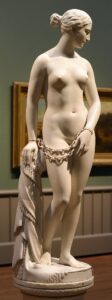
“Donation” (1863); NGV 1865, no.39 (noting the original as in the possession of a Mr Grant, Albion Street, Hyde Park); AR 1870-71, p.26 (5’2” high); NGV 1880, p.16; NGV 1894, VII.57; AR 1900, p.31: note of the loan of this cast to the Melbourne Working Men’s College (now RMIT); cf.Brucciani (1858?), cat.11, and Brucciani (1870?), p.20 (various sizes)
[photo: marble version of 1850 in the Yale University Art Gallery]
After training as a sculptor in the United States, Powers (1805-73) moved permanently to Florence in 1837. The Greek Slave, one of the most widely-publicized statues of the 19th century, was first exhibited as a plaster model in 1843 (preserved in the Smithsonian Museum, Washington), and then in several marble versions produced under Powers’ supervision from 1844 until the 1860s. The nudity of his Greek Slave shocked some viewers in America in 1847-8, but in his accompanying comments the sculptor insisted that, given the young woman’s abject fate and Christian virtue, “no room will be left for shame.” Perhaps so, but this seems to be a classic example of a Victorian artwork that suggests both moral probity and titillation. Melbourne’s cast is clearly visible in the background of Charles Rudd’s 1887-87 view of the collection (NGV): see Casts – Overviews.
The pre-Felton collection also included albums of photographs by the sculptor’s son Longworth Powers (1835-1904) – refer linked entry for further details, and reproductions of several of his father’s statues, including the present figure and The Last of the Tribes (1867-72), another famous work, personifying the disappearing Native Americans.
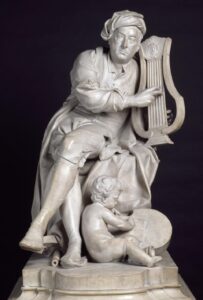
Cast: AR 1870-71, p.26
[photo: V&A statuette]
This cast probably reproduced the marble statuette of the famous Baroque composer (1685-1759), now in the V&A Museum, by the French-English sculptor Louis François Roubiliac (1702-62). Originally installed in London’s Vauxhall Gardens in 1738, the statue, only c.1.35 m high, but on a substantial marble plinth, is said to have made Roubiliac’s reputation. In 1854, it was purchased by the Sacred Harmonic Society and installed in their London offices, and was later owned by music publishers Novello & Co., before being bought for the V&A in 1964. The Melbourne collection also included a separate plaster bust of Handel, possibly based on another Roubiliac original: see now II.56.
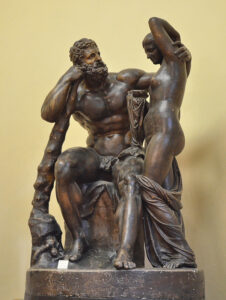
“Donations” (1863); NGV 1865, no.40; AR 1870-71, p.26 (6’1” high); NGV 1880, p.16; NGV 1894, VIII.103
[photo: Flaxman’s statue at Petworth House, Sussex (photo by David Ward, Feb..2017: see https://www.flickr.com/photos/70607220@N04/32668261502; accessed 26 Aug.2020)]
This statue of 1792 is described in the 1851 catalogue of the Flaxman Gallery, University College, London (later the Slade School), as follows: “The trunk and thighs are cast from the antique; the rest of the group is the work of Flaxman” (SLV copy, formerly owned by Augustus Tulk, donated by his widow in 1879); the antique source was clearly the famous Belvedere Torso in the Vatican (see Haskell & Penny 1981, cat.80).
The early Melbourne sources describe this group (intended for a marble statue which did not eventuate) as showing Hercules and Omphale, the Lydian princess to whom Hercules was bound in servitude. However, Flaxman’s statue was definitely intended to show the Marriage of Hercules to Hebe, the daughter of Zeus and Hera, who “presents him with the cup of immortality” (as explained in a letter of March 1792): see now G.Bentley, “Flaxman in Italy,” Art Bulletin Dec.1981, pp.658-64, esp.p.661 and fig.7. Another book in the Melbourne library as early as 1857, G.F.Waagen’s Treasures of Art in Great Britain, London, 1854, vol.II, p.319, suggests that the idea of the figure as Hebe was suggested to Flaxman by a passage in Hesiod.
For Flaxman (1755-1826), see also casts I.82 & 83 (Mercury and Pandora), and II.49 (his bust); and see also Wedgwood [DA], for a late 18th-century blue jasper plaque after Flaxman, purchased for the pre-Felton collection in 1877, and still in the NGV.
I.63 Hercules (statuette) {1904}
AR 1904, p.25 (describing the original as in the British Museum; price: £0/15/-); cf.Brucciani (185?), cat.no.144: “Hercules Farnese, reposing” {sic}
The source of this cast is uncertain. It may have been based on a Farnese Hercules-related bust in the British Museum (18776,1108.2); but see also Brucciani as cited above.
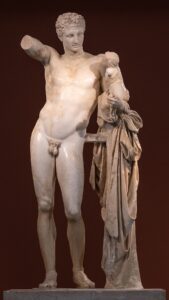
AR 1880, p.73: NGV 1894, VIII.109 (describing the original as in the Royal Museum, Berlin)
[photo: statue in Olympia]
The statue in the Archaeological Museum, Olympia, excavated by German archaeologists at the site in 1877, is generally argued to be an original statue by Praxitiles, although some regard it as a later replica. The reference in NGV 1894 to the source as a statue in Berlin seems to be an error, unless another copy or cast was the source.
I.65 Hermes {1892}
AR 1892, p.23; not listed in NGV 1894
It is unclear whether this cast, described in the NGV’s 1892 Annual Report as a “plaster statue,” referred to a second copy of the Hermes & Dionysus listed in NGV 1880 and NGV 1894 (see previous entry), or another cast.
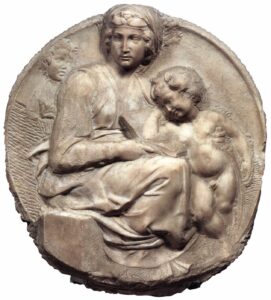
Summers list 1861, no.24 (“Relieve of the Holy Family by M.Angelo … smashed,” possibly referring to this cast; but see also I.67); AR 1870-71, p.43; NGV 1880, p.33; NGV 1894, VIII.98; cf.Brucciani (1870?), p.38
[photo: original relief (Bargello, Florence)]
Michelangelo’s tondo, c.1503-4, commissioned by Bartolomeo Pitti, was purchased for the Uffizi in 1823, and transferred to the Bargello in 1873. It shows the Virgin and Child with the infant St John the Baptist (not a Holy Family, in which Joseph would appear), dominated by the Madonna, scarcely contained by the circular frame, with St John in low relief to the left. A letter from High Childers to Redmond Barry, October 1860 (see Galbally, “Lost museum,” 1988, p.37) refers to “3 slabs by Michelangelo,” of which this cast was probably one; see also next entry.
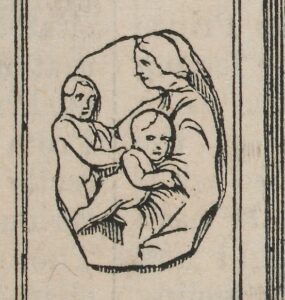
AR 1870-71, p.43; NGV 1880, p.33 (noting 2 casts); NGV 1894, VIII.3; cf.Brucciani (1870?), p.38 & Brucciani (1891), p.21 [no.2320]
[photo: detail of 1863 engraving of Melbourne’s casts (SLV)]
Michelangelo’s second marble tondo of the Virgin and Child with St John, of c.1504-6, was commissioned by the Florentine cloth merchant Taddeo Taddei. It differs markedly from the Pitti Tondo (see I.66) in the stronger emphasis given to St John the Baptist, at the left, and the prominence of the central Christ Child, moving diagonally towards his mother (for a photograph of the original, see next entry). It was bought by Sir George Beaumont in 1822, and bequeathed to the Royal Academy in 1829. This cast was an early acquisition for Melbourne, clearly recognizable, despite the indifferent quality of the engraving, in the view of the collection published in the Australian news for home readers, 21 Oct.1863.
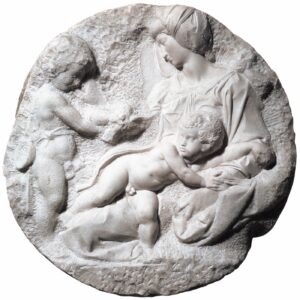
NGV 1880, p.33 (noting 2 casts); NGV 1894, VII.4; cf.Brucciani, as cited under I.67
[photo: original relief: Royal Academy]
For the source, see previous entry. This was Melbourne’s second cast of the Taddei Tondo, one of several casts donated by Wood, who worked in Melbourne 1877-82 (see also Casts – Donors).
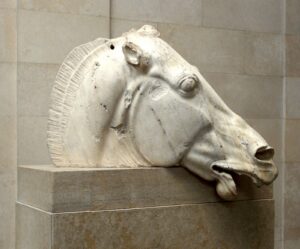
NGV 1865, no.41; AR 1870-71, p.40; NGV 1880, p.16; NGV 1894, VIII.58; cf.Brucciani (1870?), p.36,Brucciani (1905), p.19 (ill.)
[photo: the original sculpture (British Museum 1816,0610.98)]
The source was one of the Elgin Marbles statues originally decorating the Athens Parthenon: see general remarks under I.51 and I.90. Melbourne’s cast was probably the basis for an oil study for which local painter Meyer Altson won a prize while studying at the National Gallery School in 1899: see now * Altson (M.) Monochrome Head of Horse {1899} Loc? [PA].
I.70 The Hours Leading the Horses of the Sun (Gibson, c.1) {c.1860}
NGV 1870-71, p.43; NGV 1880, p.33; NGV 1894, VIII.114; cf.Brucciani (1870?), p.38
[photo: Royal Academy cast (c)]
John Gibson (1790-1866) led a successful career as a neoclassical sculptor in England (see also I.111). The source for the present cast was Gibson’s classicizing marble relief of c.1849 (Wentworth WoodHouse, Yorkshire), shown at the Great Exhibition in 1851. There is also a plaster cast of this relief in the Royal Academy, donated by the artist in 1866: photo reproduced here. Melbourne’s collection also included a second cast, donated later (see next entry).
I.71 The Hours Leading the Horses of the Sun (Gibson, c.2) {presented by Marshall Wood, Esq., c.1877-82}
NGV 1894, VII.89
For details, see previous entry.
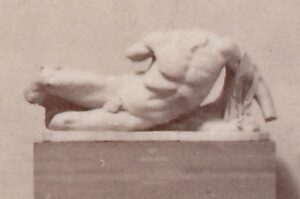
NGV 1865, no.42; AR 1870-71, p.40; NGV 1880, p.16; NGV 1894, VIII.49; cf.Brucciani (1891), p.4, & Brucciani (1905), p.19 (ill.)
[photo: detail of Nettleton photo of the Melbourne casts, 1872 (SLV H96.160/1789)]
The statue in the British Museum (1816,0610.99) was originally from the East pediment of the Parthenon (by Phidias, 438-32 BC): see now I.51. Plans to uncover the actual Ilissos river in Athens, mostly underground since the 19th century, were announced in 2019.
I.73 Innocence (Foley) {presented by Henry Arthur Smith, Esq., 1863}
“Donations” (1863); SB p.8; NGV 1865, no.43 (as after Foley; noting the original as in the collection of a certain Mr Pearce; 5′ high); AR 1870-71, p.26; NGV 1880, p.16; NGV 1894, VII.98
[photo: Melbourne’s cast as visible in photograph by Charles Rudd, 1886-87 (NGV)]
Melbourne’s cast is identified in NGV 1865 and later Melbourne references as Innocence, after a statue by Irish sculptor John Henry Foley (1818-74), and a figure identified with these details (on the plinth) appears in Charles Rudd’s overview of the Melbourne collection, 1886-87 (NGV), as reproduced here. However, the figure represented is clearly a nymph (or Venus?), struggling to cover her body with drapery, which seems incongruous in terms of the iconography of “Innocence.” Foley, noted particularly for his “Asia” group for the Albert Memorial, and the central statue of the Prince Consort himself, is documented as exhibiting a statue called Innocence at the Royal Academy in 1839, and then a second marble statue (1848), reproduced in engraved form in 1851, as well as Parian statuettes (1846 etc.); but they all show a young woman cradling a bird. Perhaps the identification of Melbourne’s cast was confused with another work (as in the case of I.17: see above). See also * Unknown (British 19C) Innocence {c.1860} Loc? [SC], a Parian bust.
In AR 1908, Melbourne’s cast was listed among a number lent to the Trustees of the Exhibition Building.
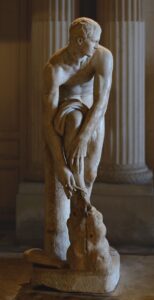
Cast: NGV 1865, no.44; NGV 1870-71, p.40 (4’8” high); NGV 1880, p.16; NGV 1894, VIII.77
[photo: Louvre statue]
The source is identified in AR 1870-71 and subsequent NGV catalogues as a statue in the Louvre (discovered in Rome in the 16th century, then to the Montalto collection; purchased by Louis XIV 1685); see Haskell & Penny 1981, cat.23 (Cincinattus), and B.S.Ridgway in Am.J.Archaeol. 68.2 (April 1964), pp.113-28: Roman copy of C2 BC statue, now generally called “Sandalbinder.” Melbourne’s cast is clearly visible at the far right of the overview of the collection, c.1880 (SLV H11790).
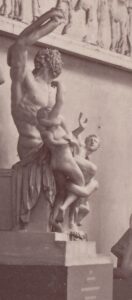
NGV 1865, no..52; AR 1870-71, p.40 (as 6’10” in total height); NGV 1880, p.17; NGV 1894, VIII.24; cf.Brucciani (1858?), cat.1, and later Brucciani catalogues
[photo: detail from overview of Melbourne’s casts by Nettleton, 1872 (SLV H96.160/1789)]
Haskell & Penny 1981, cat.52, provide a detailed acount of the Vatican statue, discovered in Rome in 1506, and widely admired, copied and adapted ever since. The statue was already famous before its discovery, through the account by Pliny the Elder (c.24-79 AD), who described it as the work of Hagesandrus, Polidorus and Athenodorus of Rhodes, and judged it, “of all paintings and sculptures, the most worthy of admiration.” The Vatican group is generally considered a late Hellenistic work from Pliny’s own era, possibly based on a Pergamene statue (in bronze?) from c.200 BC. The 1894 NGV catalogue notes various historic restorations, still evident in older photographs (see e.g. Haskell & Penny, p.245), but removed by modern “re-restoration,” which has also incorporated the fragmentary bent arm of the central figure, discovered in the 1950s. NGV 1894 also includes a lengthy synopsis of the story; see also Virgil’s Aeneid, book 2. The original group is almost 2.5 metres high, but copies and casts were often made at reduced scale, or of details like Laocoon’s head (see II.71). See also Girard after Reverdin Laocoon {by 1861} NGV [PR] (with further details and references on the Vatican group)
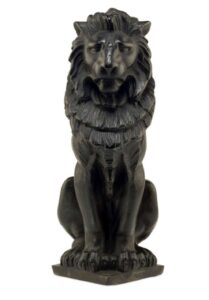
AR 1904, p.25 (price: £0/7/6; “from British Museum Railings”)
[photo: one of the original bronze lions, British Museum (1983,1205.1)]
The lions designed by Alfred Stevens (1817-75) for the British Museum fence in about 1852 were removed in 1896 during refurbishments, but several remain in the Museum’s collection. In 1896, Brucciani & Co. were given permission to produce commercially-available plaster casts; other casts are held in the V&A and elsewhere.
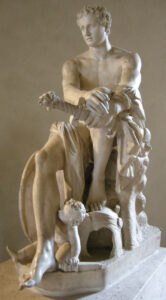
Not listed in NGV 1865; AR 1870-71, p.41; NGV 1880, p.19 (as “Mars resting”; height given as 4’10”); NGV 1894, VIII.43; cf.Brucciani (1891), p.4 (no.2329) (?)
[photo: Ludovisi Ares]
AR 1870-71 and NGV 1894 both indicate that the source was a statue in the Vatican, but the respective descriptions of him “sitting” or “resting” seem to point to the likely source as the seated Ludovisi Ares in the Museo delle Terme (Haskell & Penny 1981, cat.58) which, at about 1.5 metres high, is approximately the same size as this cast. The only statue of Mars/Ares in the Vatican is the rare 5th-century BC Etruscan bronze “Mars of Todi,” acquired shortly after its discovery in 1835 (Gregorian Etruscan Museum, Inv. 13886); but it seems unlikely that that remarkable work would have interested 19th-century Melburnians (even if a cast existed); and he is shown standing.
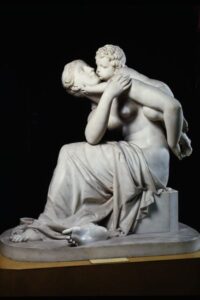
“Donations” (1863); NGV 1865, no.50; AR 1870-71, p.27 (as 2’11” high; identifying the original as in the collection of Joseph Neeld, the work later acquired for the V&A); NGV 1880, p.19 (2’11” high); NGV 1894, VII.106; cf.Brucciani (1870?), p.18 (3’ high)
[photo: original statue in the V&A (A.33-1964)]
Baily (see cast I.50) developed this composition from 1823 onwards, culminating in the marble version in the V&A, dated to 1837, the basis for Melbourne’s cast. The interestingly muscly awkwardness of the figures makes it easy to recognize in the 1863 engraving of the MPL casts. For other casts after Baily, see I.50 and II.20. This one was listed in AR 1906 as lent to the Bairnsdale School of Mines.
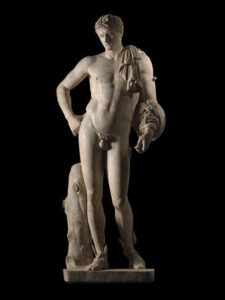
Not listed in NGV 1865, AR 1870-71 or NGV 1880; NGV 1894, VIII.53; cf.Brucciani (1870?), p.8 & Brucciani (1891), p.4 (no.2330; as via a British Museum original)
[photo: statue in the British Museum (1864,1021.1)]
Melbourne’s cast is not recognizable in overviews of the collection, and NGV 1894 provides no details regarding the source. The most likely possibility seems to be the British Museum statue formerly in the Farnese Palace in Rome, a Roman copy of an original thought to be by Praxiteles (also reproduced by Brucciani as a cast): see photo. For Melbourne casts of other statues of Mercury, see entries following.
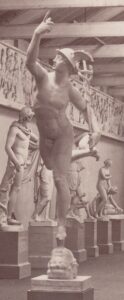
“Donations” (1863); NGV 1865, no.48; AR 1870-71, p.26 (as 4’3” high; original identified as in Royal Gallery, Florence): NGV 1880, p.19; NGV 1894, VIII.111; cf.Brucciani (1870?), p.14
[photo: detail of Charles Nettleton photo of Melbourne’s casts, 1872 (SLV H96.160/1789)]
This statue is known in several versions, of which the 1580 bronze in the Florence Bargello was evidently the model for this cast, prominent in several general views of the Melbourne collection. For Flemish/Italian sculptor Giambologna (c.1529-1608), see * Giambologna [after] Rape of the Sabines {1878} Loc? [SC], also in the pre-Felton NGV.
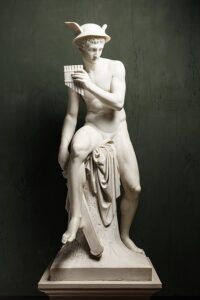
NGV 1865, no.47; AR 1870-71, p.41 (5’6” high; original noted as in the collection of the Prince of Augustenberg); NGV 1880, p.19; NGV 1894, VII.42; AR 1900, p.31: note of the loan of this cast to the Melbourne Working Men’s College (now RMIT)
[photo: original statue in Copenhagen]
This cast was listed among several lent to the Working Men’s College (now RMIT) in 1900 (AR 1900, p.31), possibly indicating its later fate. The source was Mercury about to kill Argus (Thorvaldsensmuseum, Copenhagen, 1818), by Danish neoclassical sculptor Bertel Thorvaldsen (1770-1844), as reproduced here. The princely owner mentioned in AR 1870-71 was evidently Prince Frederick (1800-1865), a member of the Danish royal family of the day, whose portrait bust by Thorvaldsen is also held in the Copenhagen museum. For other pre-Felton casts after Thorvaldsen, see also I.85, I.88, I.111 (and see also I.3).
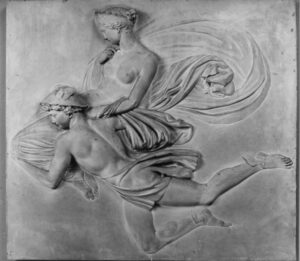
AR 1870-71, p.43; NGV 1880, p.33; NGV 1894, VIII.28
[photo of Copenhagen relief (courtesy Courtauld Institute)]
The Melbourne collection included two casts, the second donated later (see next entry); one of the two was among the casts listed in AR 1900, p.31, as lent to the Working Men’s College (now RMIT). John Flaxman’s original plaster relief (Ny Carlsberg Glyptothek, Copenhagen) was first exhibited at the Royal Academy in 1805, and subsequently reproduced in both plaster and marble versions, by Flaxman and others. For further details on Flaxman, see I.62 and II.49.
I.83 Mercury and Pandora (Flaxman) [c.2] {presented by Marshall Wood, c.1877-82}
NGV 1894, VII.26
This second cast (cf.previous entry) was donated while Wood was working in Melbourne.
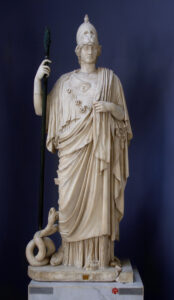
“Donations” (1863); NGV 1865, no.49; AR 1870-71, p.41; NGV 1880, p.19 (7’1” high); NGV 1894, VIII.42 (noting details of the donor); cf.Brucciani (1870?), p.8 (7’6” high)
[photo: Vatican statue]
The original statue, first documented in the Giustiniani collection in Rome in 1631, was sold to Pope Pius VII in 1817, and installed in the new Braccio Nuovo of the Vatican: see Haskell & Penny 1981, cat.63. Now seen as a Roman copy of a 4th century BC Greek bronze, it was admired by Canova and others. Melbourne’s large cast, clearly visible in several early views of the collection, appears to have been slightly less than life-size (the original measures 2.23m high, or about 8’4”).
In the list of casts identified in “Municipal Statuary” (1908) as no longer required by the NGV, this example was noted as one of the more attractive.
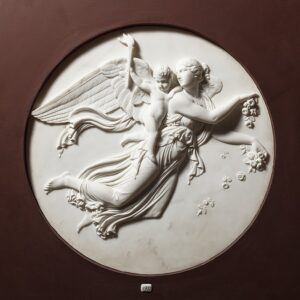
Summers list 1861, no.27 (“smashed”); AR 1870-71, p.43; NGV 1880, p.33; NGV 1894, VIII.26; cf.Brucciani (1870?), p.39
[photo: original relief in Thorvaldsensmuseum, Copenhagen]
This cast was based on a relief, usually called Day, made by Thorvaldsen in 1815, together with its pair, Night (see I.88). Further marble versions were produced by Thorvalden and his workshop during the later 1810s and 1820s: see e.g. https://www.sothebys.com/en/auctions/ecatalogue/2019/treasures-l19303/lot.32.html (with further references and reproductions; accessed 24 Sept.2020). Redmond Barry apparently had another pair of casts after these reliefs installed in his Carlton house. For other Melbourne casts after Thorvaldsen, see also I.81, I.88, I.111 (and I.3).
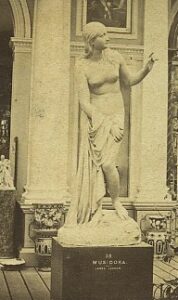
“Donations” (1863); NGV 1865, no.51; AR 1870-71, p.27 (as 5’ high; with details as quoted below); NGV 1880, p.19; NGV 1894, VII.22
[photo: detail of stereograph of the original statue, taken in 1851]
Legrew (1803-57) was a pupil of Chantrey (see II.22). His Musidora was shown at the Great Exhibition in 1851: see photo reproduced here (refer http://www.past-to-present.com/S07497 [accessed 4 August 2020]). The Melbourne references explain that the figure represented was “an imaginary person introduced by Thomson in his poem of the ‘Seasons’,” and AR 1870-71 includes a quote). Mrs Moor was presumably the wife of Henry Moor, who donated the cast of John Bell’s Dorothea (I.47), also in 1863; the two statues make a nice pair, both depicting fictional characters. Both of these casts were listed later as lent to the Exhibition Trustees (see AR 1906 and 1908).
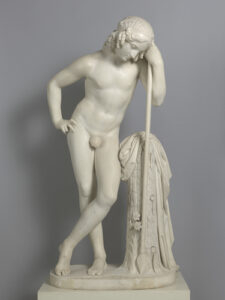
“Donations” (1863); NGV 1865, no.52; AR 1870-71, p.27 (4’11” high); NGV 1880, p.20; NGV 1894, VII.72; AR 1900, p.31, noting the loan of this cast to the Melbourne Working Men’s College (now RMIT University)
[photo: marble original in Buckingham Palace]
William Theed (1804-91) carved his Narcissus in 1847, when he was working for Queen Victoria and Prince Albert, after earlier study and work in Rome. During a long and productive career, he produced numerous portrait busts and statues, including the “Africa” group on the Albert Memorial. Details regarding the donor are somewhat unclear (for comments, see Casts – Donors).
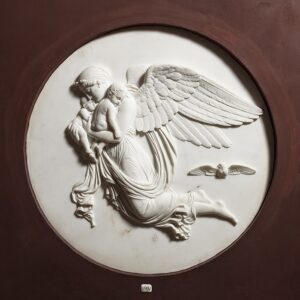
Not listed in NGV 1865; AR 1870-71, p.43 (under “Casts of Friezes”); NGV 1880, p.3; NGV 1894, VII.20
[photo: original relief in Thorvaldsensmuseum, Copenhagen]
Night, holding two sleeping children, and with poppies in her hair, is accompanied by an owl. For the companion relief, see cast I.85 (called Morning). Another cast of the present relief, produced by the English decorative plaster firm of George Jackson & Sons, is in the Victoria & Albert Museum. See also cast I.81 above, for further information on the sculptor.
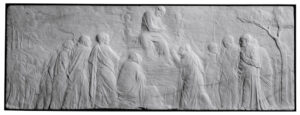
Not listed in NGV 1865; AR 1870-71, p.43; NGV 1880, p.33; NGV 1894, VII.12
[photo: original relief (V&A)]
This was evidently a cast of Donatello’s low-relief Ascension (1428-30), acquired for the Victoria & Albert Museum, London, in 1861; unusually, it combines the imagery of the Ascension with Christ giving the keys to St Peter. Ann Galbally (“Lost Museum,” 1988, p.37) quotes a letter of 26 October 1860 from Chester Waters, London agent, to Sir Redmond Barry: “I have already ordered for you the cast from Donatello’s chef d’oeuvre, lately made by the Arundal {sic} Society.” For other casts after Donatello (1385-1466), see I.40 etc.
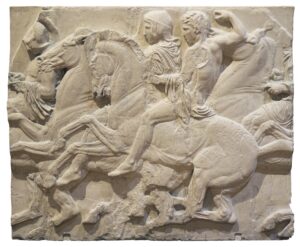
SB p.6 (£40/5/9); AR 1870-71, p.43; NGV 1880, p.34; NGV 1894, VIII.4; cf.Brucciani (1905), pp.21-24, listing 44 individual casts
[photo: one of Melbourne’s casts, still extant in the RMIT University art collection (1895.1)]
The plaster replicas of the British Museum’s Parthenon sculptures (the “Elgin Marbles”), notably these full-scale casts of sections of the remarkable frieze (c.443-37 BC), formed a key component of Melbourne’s initial order of casts in 1860, and their installation was central to the construction of suitable exhibition galleries at the Melbourne Public Library in the 1860s. Melbourne critic James Smith enthusiastically welcomed their first formal exhibition in 1865, waving aside the fact that they were plaster copies: “Enough that we can contemplate the creations of Phideas as fresh and real as if actually chiselled in the marble by his own hand” (Argus, 7 June 1865). The casts of the frieze were prominent in early views of the collection, on the walls above individual statues. For other Melbourne casts after Parthenon sculptures, see also I.51, I.69, I.72 and I.101 (and see also next entry).
Their early prestige, however, did not save these casts from later de-accessioning, along with almost all the rest of Melbourne’s cast collection. Three “slabs” from the frieze survive at RMIT, where several were transferred on loan (possibly as early as 1895): see photo above; see also Galbally & others, First Collections (1992), cat.68. Others have been glimpsed elsewhere in Melbourne from time to time; see e.g. a 1971 print of a Toorak apartment by noted local photographer Wolfgang Sievers (1913-2007), showing a further group of 3 of the casts, splendidly exhibited in a modern architectural setting (SLV H2001.40/247).
I.91 Frieze of Parthenon (“reduced by Hemming”) {by 1870}
AR 1870-71, p.43; NGV 1880, p.34 (47 slabs); not listed in NGV 1894
This second set of casts after the Parthenon frieze (see previous entry) was at reduced scale, presumably for study purposes. It is unclear whether these reproduced the same or different sections of the original frieze.
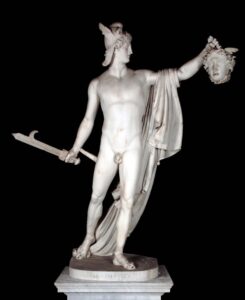
NGV 1865, no.53; AR 1870-71, p.41 (as 7’6” high; identifying the original as in the Vatican); NGV 1880, p.20; NGV 1894, VII.38
[photo: Vatican statue]
This cast was based on Canova’s Vatican statue (1800-1801), first displayed on the plinth left empty by the transfer of the Apollo Belvedere to Paris after the Treaty of Tolentino. Canova made another version in 1804-6 (now in the Metropolitan Museum in New York). Melbourne’s cast was apparently life-size (the Vatican original is about 2.35 metres high). The pre-Felton collection also included several marble statues said to be by Canova (see linked artist entry); and for other casts after him, see I.59 etc.

“Donations” (1863); NGV 1865, no.54; AR 1870-71, p.27 (5’10” high; as via a Vatican original); NGV 1880, p.20; NGV 1894, VIII.40
[photo shows Melbourne’s cast in the background, partially visible in overview 1880s-90s (SLV H11790)]
Polyhymia is usually identified as the Muse of Sacred Poetry. Melbourne’s cast is partially visible in the background of the view of the collection as shown here, leaning reflectively on a rocky pillar, behind the cast of I.36 (Dancing Faun). However, the exact source is something of a puzzle. The early NGV references indicate that it was based on a statue in the Vatican, presumably the Polyhymnia in the Museo Chiaramonti (Inv.1839), said to be based on a Hellenistic work of the 2nd century BC, considerably restored (the head is from another source, and she leans on a balustrade, which looks oddly modern). A variant in the Louvre (Ma 472), more closely similar to the Melbourne cast, is described as a Roman work with additions by Borghese restorer Agostino Penna (1780). There is also a similar version, now in the Centrale Montemartini, Rome: see https://followinghadrian.com/2015/10/15/when-in-rome-a-visit-to-the-centrale-montemartini/ (accessed 24 Sept.2020), but that statue was excavated in Rome only in 1928. Perhaps the Melbourne cast was based on the Vatican statue before it was altered by restorations? In AR 1908, it was listed in AR 1908 as one of the casts lent to the Exhibition Trustees.
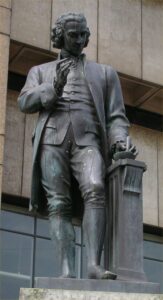
AR 1875, pp.38-39 (as quoted below); NGV 1880, p.26; NGV 1894, VII.85
[photo: Birmingham statue]
The NGV’s Annual Report for 1875, reporting the donation of this cast, provides further identifying details: “A statuette of Dr Priestley, from the statue by G.J.Williamson {sic}, erected at Birmingham.” Joseph Priestley (1733-1804), was an extraordinary figure, noted equally as chemist, philosopher, theologian and Dissenter. From 1780 to 1791, he was active both in scientific research and radical politics in Birmingham, inspiring riots in 1791. In 1794 he moved to the United States, where he remained until his death. A marble statue of him by Francis John Williamson (1833-1920) was unveiled in Birmingham in 1874 (later replaced by a bronze replica: see photo reproduced here). The donor of this cast, a noted ophthalmic surgeon in Melbourne (1837-93), trained in Birmingham (see Casts – Donors). Melbourne’s small cast is recognizable in the right background of the photo of the collection by Charles Rudd, 1886-87 (NGV): see Casts – Overviews. A set of Priestley’s published works (28 volumes, Birmingham, 1760-85), was one of the earliest acquisitions for the Melbourne Public Library: see MPL 1854, p.36.
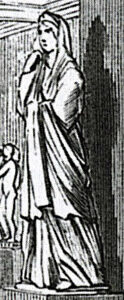
“Donations” (1863); NGV 1865, no.55; NGV 1870-71, p.27 (6’5” high; original in the Vatican); NGV 1880, p.20; NGV 1894, VIII.22
[photo: Melbourne’s cast as shown in 1866 engraving]
The Vatican statue, also sometimes identified as Augustus’ wife Livia, was widely admired in the 18th century: see Haskell & Penny (1981), cat.74. Melbourne’s cast is easily recognizable in several of the early views of the Melbourne cast collection: detail shown here from engraving published in Illustrated Melbourne Post, 27 July 1866 (SLV). The donor, listed simply as “Miss Barry” in the early Melbourne references, may have been either Caroline Barry (c.1821-72) or Charlotte Barry (c.1824-1901): for details, see Casts – Donors.
Later, Melbourne’s copy was noted as one of the more desirable casts offered to interested parties – see “Municipal Statuary” (1908) – and listed as lent to the Trustees of the Exhibition Building (AR 1908).
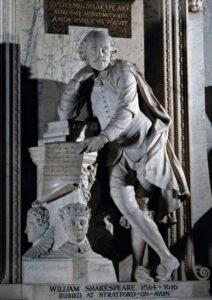
AR 1872, p.28 (as by William Kent; acquired from D.Brucciani); NGV 1880, p.20 (as 5’2″ high); NGV 1894, VII.5
[photo: Westminster Abbey statue]
The original statue, erected in 1740, was carved by Peter Sheemakers (1691-1781), a Flemish-born sculptor active in Britain, to a design by William Kent, who was responsible for the overall appearance of the Westminster Abbey monument. The 1880 NGV catalogue (p.20) lists the cast as 5’2” high. This cast, clearly identified as the Westminster Abbey figure, was later sold for £4: see 1943 auction of NGV sculpture. For a plaster bust of Shakespeare also in the Melbourne collection, see II.115.
I.97 Slave [statuette] (Michelangelo) {1904}
AR 1904, p.25 (price: £1/5/-); cf.Brucciani (1891), p.5 (no.2269, priced at £1/1/-)
There is no mention in AR 1904 of which of Michelangelo’s slaves/prisoners was the basis for this cast; likewise, the cast available from Brucciani (1891) was also unidentified. The most famous of the original statues, made for the proposed Tomb of Julius II, is the so-called “Dying Slave” in the Louvre (1513-16).
I.98 Sophocles {presented by Colonel Barry, 1863}. Private collection, Melbourne
“Donations” (1863); NGV 1865, no.57; AR 1870-71, p.27 (6’8” high; original in the Lateran); NGV 1880, p.21; NGV 1894, VIII.45 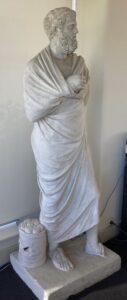
[photo of the extant cast (taken by the present owner, 2022)]
The source is a statue formerly in the Lateran (now Vatican, Museo Gregorio Profano, Inv.9973), a Roman copy of a Greek bronze of the playwright (c.496-405 BC), shown with a box of scrolls at his feet. Melbourne’s cast, clearly visible in several early views of the collection (e.g. SLV H22789), was the same size as the original. See also II.117 (Head of Sophocles). For the donor, one of Redmond Barry’s brothers, see Casts – Donors.
This particular cast has an intriguing post-1904 history. In 1908, it was recorded among those no longer required by the NGV – see “Municipal Statuary” (1908) – and then listed as lent to the Trustees of the Exhibition Building (AR 1908). Then, in 2023, it was confirmed as owned by a Melbourne architect, who advised that he received it in part payment from painter Jan Senbergs (b.1939), who had inherited it while teaching at the RMIT Art School which absorbed the old National Gallery School (many thanks for these details and the attached photo, which shows the cast in good condition, give or take a few toes!).
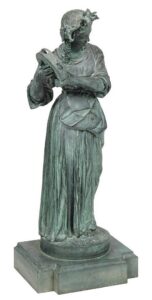
“Donations” (1863); NGV 1865, no.59; NGV 1880, p.21 (as 4’8” high); NGV 1894, VII.33 (as by Danton {sic}); cf.Brucciani (1858?), cat.26 (“Neapolitan Girl [Danton]”)
[photo: bronze statuette auctioned in France 2014]
This cast appears to correspond to the cast listed by Brucciani (1858?). The original was presumably “Jeune fille napolitaine jouant du tambourin” by French sculptor Antoine-Laurent Dantan (1798-1878), first shown as a plaster figure at the 1837 Paris Salon. Smaller bronze casts ensued, and some still appear at auction, e.g. the figure reproduced here, 45 cm high, auctioned in France in 2014: see https://www.invaluable.com/auction-lot/antoine-laurent-dantan-1798-1878-jeune-napolita-172-c-dfdce641a0 (accessed 6 August 2020). Melbourne’s cast was listed in AR 1908 as one of those lent to the Exhibition Trustees.
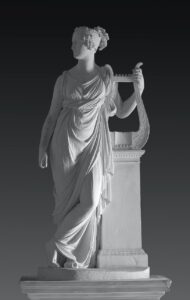
“Donations” (1863); NGV 1865, no.60; AR 1870-71, p.27 (5’8” high; original identified as Coll.Count Sommariva, Paris); NGV 1880, p.21; NGV 1894, VII.83
[photo: original model in Villa Carlotta]
Terpsichore, as the early Melbourne references explain, was the Muse of Dance and Song; cf.I.49 (Euterpe) and I.93 (Polyhymnia). Canova’s statue was made for Giovanni Battista Sommariva in 1811; the original plaster model (Villa Carlotta, Lake Como), retains the “markers” used in the process the sculptor used to make marble replicas: see photo at right. Melbourne’s copy was listed in “Municipal Statuary” (1908) as one of the “extremely grateful and decorative” casts no longer required by the NGV, and in AR1908 it was listed as lent to the Exhibition Trustees.
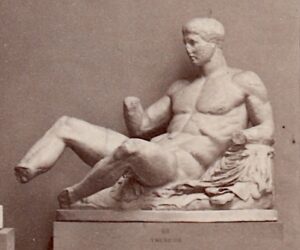
NGV 1865, no.61; AR 1870-71, p.41; NGV 1880, p.21; NGV 1894, VIII.110; cf.Brucciani (1905), p.16 (ill.)
[photo: Melbourne’s cast as shown in collection overview, c.1880 (SLV H11790])
This cast, from the Elgin Marbles group (see I.51 etc.), reproduced the famous reclining figure from the East Pediment of the Parthenon, which showed the Birth of Athena. Traditionally called Theseus, this figure is usually identified now as Dionysos. Melbourne’s cast is clearly recognizable in several early views of the collection.
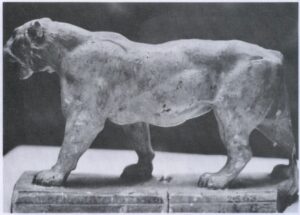
AR 1870-71, p.28? (IV.Casts of Animals: 1 Lioness); cf.Brucciani (1891), p.31 (no.2563: as “Tiger, by Barry”)
[photo: cast at RMIT University, c.1988 (photo: Alison Inglis)]
The photograph reproduced here, published by Ann Galbally (“Lost museum,” 1988, p.45, fig.9), shows this cast at RMIT University, describing it as “Lion fragment, cast by Brucciani”. The number 2563, visible on the plinth at lower right, identifies it clearly as the cast sold by Brucciani as “Tiger, by Barry” (see above). But the available records demonstrate considerable ambivalence (confusion?) as to whether the animal shown in this cast and other comparable works was a lion(ess) or a tiger. The only comparable reference in the MPL records seems to be a “lioness” listed in AR 1870-71, p.28, as listed above (part of Murphy’s 1862 donation).
The original work was obviously by the noted French animalier Antoine-Louis Barye (1796-1875), several of whose bronzes entered the NGV collection later, including a very similar animal called “Walking tiger,” acquired through the Felton Bequest in 1927 (dated c.1841; cast c.1900; size given as 29.7 x 45.8 x 16 cm): see https://www.ngv.vic.gov.au/explore/collection/work/3319/ (with photo). The NGV bronze is actually mounted on a wooden plinth labelled with the discernible title “Lionne marchant,” and was purchased together with a matching male lion. Another closely comparable bronze in the Art Gallery of New South Wales, purchased in 1944, is catalogued as “Tiger walking” (but citing 19th-century references using both titles!). These variations (also reflected in recent auction results) suggest that Barye used the same basic mould or model for his sculptures of both animals; one bronze example auctioned at Sotheby’s, New York, 9 May 2013, clearly includes tiger stripes, apparently incised onto the animal. Incidentally, Brucciani (1891) lists two casts, numbered 2562 (Lion) and 2563 (Tiger), each as by “Barry,” and each priced identically at £0/7/6; and the list of Murphy’s donations in AR 1870-71 also includes a lion (no longer extant?). I have yet to check Stuart Pivar, The Barye Bronzes: a Catalogue Raisonné (Woodbridge, 1974).
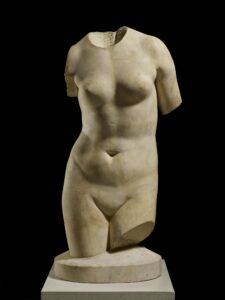
AR 1870-71, p.28 (“Venus, torso of”; as presented by Murphy); NGV 1894, VIII.63: as “torso (life size),” identifying Murphy as the donor, and the source as a statue in the British Museum)
[photo: British Museum statue (1821,0101.1)]
This cast, catalogued in NGV 1894 as shown above, is presumably the one listed in AR 1870-71 amongst the casts Murphy donated to the Melbourne School of Design, described as a torso of Venus (without indicating its origin). The likely source is the statue reproduced here, acquired by the British Museum in 1820 (1821,0101.1), and regarded as a 1st-century AD Roman copy after a Greek original. See also I.52.
I.104 Torso (life size) (c.2) {presented by Marshall Wood, Esq., c.1880?}
NGV 1894, VIII.64 (again, noting British Museum source: see previous entry)
This cast, catalogued in NGV 1894 immediately following the previous entry, probably based on the same source.
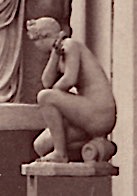
NGV 1865, no.62; AR 1870-71, p.27 (2’8” high; noting Vatican original); NGV 1880, p.21; NGV 1894, VIII.2; cf.Brucciani (1858?), cat.14 & Brucciani (1870?), p.8 (4’6” high)
[photo: cast as shown in Melbourne collection overview, c.1869 (SLV H22789)]
The source, a Hellenistic “Crouching Venus” in the Pio-Clementine Museum at the Vatican, was found at Salona, near Split (Croatia), in the later 18th century (not at Salome, near Rome, as indicated in NGV 1894). There are various other versions of the type, meaning “Venus rising from the sea” (as the Melbourne references explain), e.g. in the Uffizi (see Haskell & Penny 1981, cat.86). Melbourne’s copy was listed in AR 1909 as one of several lent to the Trustees of the Exhibition Building.

NGV 1865, no.65; AR 1870-71, p.42 (5’4” high; orginal in the Louvre, by Praxiteles?); NGV 1880, p.23; NGV 1894, VIII.8; AR 1900, p.31: note of the loan of this cast to the Melbourne Working Men’s College (now RMIT); cf.Brucciani (1870?), p.8 (6’ high) & Brucciani (1891), p.4 [no.2388]
[photo: Melbourne’s cast as visible in Charles Nettleton’s overview of the collection, c.1872 (H96.160/1790)]
The source, also known as the “Aphrodite of Fréjus” (Louvre Inv.MR 367), was discovered in 1650, and is now regarded as a Roman copy after a lost original by Callimachus.
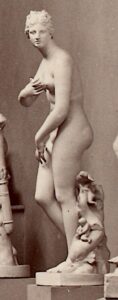
Summers list 1861, no.5 (“Body broken in pieces”); NGV 1865, no.63; AR 1870-71, p.41 (5′ high; original in the Royal Gallery, Florence); NGV 1880, p.22; NGV 1894, VIII.72; cf.Brucciani (1858?), cat.19 (& later Brucciani cats.)
[photo: Melbourne’s cast as shown in collection overview, c.1880 (SLV H11790]
This cast, one of the first acquisitions for Melbourne, was apparently at the same scale as the original in the Uffizi (first documented in 1638: see Haskell & Penny 1981, cat.88, noting that it is now seen as a copy of the 1st century BC, possibly Athenian, of an original from the circle of Praxiteles). NGV 1865 and AR 1870-71 both note “two copies” (the second probably part of Murphy’s 1862 donation: see AR 1870-71, p.28), but only one cast was listed in NGV 1880 and 1894; perhaps the damage noted by Charles Summers in 1861 to the original cast led to its replacement by the Murphy version? The pre-Felton collection also included a reduced-scale marble copy, documented as donated in 1878 but seemingly already in the NGV by 1872: see * Unknown (Italian 19C?) Venus de’Medici {1878} Loc? [SC]. There was also a cast of the Venus de’Medici in Sydney (1888 catalogue, p.91, noted as full size). All these casts and copies testify to the continuing popularity of the statue in the 19th century, though its reputation has fallen since (see Haskell & Penny).
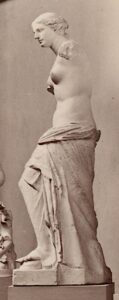
Summers list 1861, no.10 (“Head and body much broken”); NGV 1865, no.66; AR 1870-71, p.42 (as Venus Victrix; 6’8” high); NGV 1880, p.23; NGV 1894, VIII.106; cf.Brucciani (1858?), cat.66 & later eds.
[photo: Melbourne’s cast as shown in collection overview, c.1880 (SLV H11790)]
The famous original was found on the Aegean island of Milos in 1820 and transported to France in 1821: see Haskell & Penny (1981), cat.89. The current Louvre catalogue describes it as Hellenistic work of c.100 BC. In 1992, Melbourne’s cast was identified as at RMIT University (see Galbally, First Collections, 1992, cat.67), but it is unclear whether it is still there now. For a cast of the head, see also II.125.
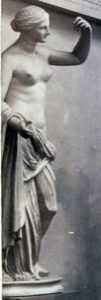
NGV 1865, no.64; AR 1870-71, p.41 (6’11” high); NGV 1880, p.23; NGV 1894, VIII.17; cf.Brucciani (1870?), p.8 (cast 7’6” high)
[photo: cast as shown in Melbourne collection overview, 1872 (SLV H96.160/1789)]
The Townley Venus, a Roman statue found in Ostia in 1775, was widely admired, especially in England (see Haskell & Penny 1981, p.58). Melbourne’s copy was listed in AR 1908 as lent to the Exhibition Trustees.
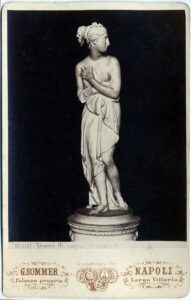
NGV 1865, no.67; AR 1870-71, p.42 (5’6” high); NGV 1880, p.23; NGV 1894, VII.108; cf.Brucciani (1870?), p.15 (5’9” high)
[historic photo of original by Giorgio Sommer]
There are various versions of this figure, known as the Venus Italica, said to have been commissioned by Napoleon. One of the earliest appears to be the Pitti Palace statue (c.1804?), reproduced here in a photo of c.1860.
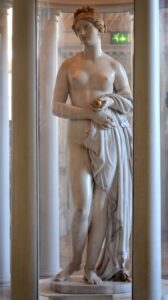
“Donations” (1863); NGV 1865, no.68; AR 1870-71, p.27 (5’6” high); NGV 1880, p.24 (describing the original statue as “in the possession of Mr Robert Berthon Preston of Liverpool”); NGV 1894, VII.2
[photo: Gibson’s statue in Walker Art Gallery, Liverpool]
Gibson (1790-1866) led a successful career in England; see also I.70-71. The source for this cast was evidently his famous Tinted Venus (c.1851-56), of which there are many variants, including a marble statuette in the Art Gallery of New South Wales (acquired in 1892).
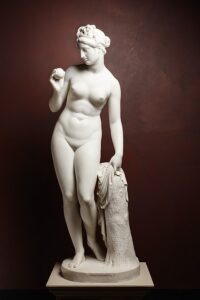
“Donations” (1863); NGV 1865, no.69; AR 1870-71, p.27; NGV 1880, p.24 (5’5” high); NGV 1894, VII.92; cf.Brucciani (1858?), p.7, no.18 (a cast noted as based on the marble version made for Lord Lucan in c.1824), & Brucciani (1870), p.15 (5’9” high)
[photo: original statue in Copenhagen]
The original statue (1813-16) shows Venus with the apple she was awarded after winning her beauty contest with Juno and Minerva, as judged by Paris (Thorvaldsensmuseum, Copenhagen, A853): see photo at right. For other casts after Thorvaldsen, see I.81 etc.
Melbourne’s cast is clearly visible to the right of centre in the photograph of Melbourne’s collection taken by Charles Rudd, 1886-87 (NGV): see Casts – Overviews, no.9. Its later fate (as with most of Melbourne’s casts) is unclear. However, it may have been the cast identified in “Municipal Statuary” (1908) as “Hebe with her apple” (apparently a misunderstanding, as an apple does not seem to be part of Hebe’s usual imagery; cf.I.62 above).
I.113 Virgin (F.Davis) {by 1870}
AR 1870-71, p.43 (“in relief”); NGV 1880, p.33 (Holy Virgin; original by Davis); NGV 1894, VII.37
To date, these details have not proved sufficient to identify an original sculpture, although AR 1870-71 clarifies the fact that this was a relief.
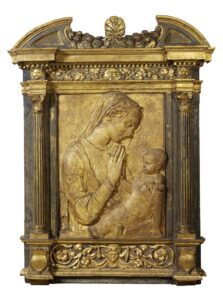
SB p.6; NGV 1880, p.34; NGV 1894, VII.91 (noting the original as in the South Kensington Museum) or VII.92
[photo: V&A relief (57:1-1867)]
This cast was probably based on the gilded terracotta relief of c.1455-60 (Victoria & Albert Museum), reproduced here. I.115 may have been a second cast of this relief, or based on a different original. For the general problem of the 19th-century proliferation of works alleged to be by (or casts after works by) Donatello, see I.40, II.26, II.47 etc.
I.115 Virgin and Child (Donatello) {presented by the Education Department, Melbourne, 1893}
AR 1893 (report on the NGV Drawing School by F.McCubbin: as a relief); NGV 1894, VIII.91 or 92
Without further information, it is impossible to say whether this was a duplicate cast (cf.previous entry), or a copy of another work by or said to be by Donatello.

AR 1893 (report on the NGV Drawing School by F.McCubbin, as a bas-relief); NGV 1894, VIII.81 (“Relief from the Frieze of the Temple of Nikè Apteros. Original in the British Museum”); cf.Brucciani (1891), p.21 (no.2355)
[photo: Nike relief in the Acropolis Museum, Athens]
The description of this cast in NGV 1894 (as quoted above) is contradictory. The Temple of Athena Nike on the Athens Acropolis was decorated with a frieze which included the famous relief of Nike Apteros (literally meaning “wingless Victory”) adjusting her sandal, now in the Acropolis Museum, and dated to c.420-410 BC: see photo reproduced here. Brucciani & Co. sold a cast of this figure. The only comparable object in the British Museum is not a relief, but a fragmentary winged Nike figure, probably an acroterion (1816, 0610.321), also dated to c.420-400 BC, purchased in 1816 from Lord Elgin, who collected it with the Parthenon sculptures.
I.117 Youth Invoking the Gods {by 1865}
NGV 1865, no.71; NGV 1880, p.24 (4’3” high); NGV 1894, VIII.101 (‘original bronze in Berlin”)
[photo: detail of this cast in overview of Melbourne’s collection, c.1880 (SLV H4578)]
The source, a bronze statue now in Berlin’s Altes Museum, was found in Rhodes and taken to Venice in 1503; later, it was purchased by Frederick II of Prussia. Although much restored (including the added praying arms), it is regarded as a Hellenistic work, perhaps made by a follower of Lysippus, c.300 BC.: for details, see https://artsandculture.google.com/asset/der-betende-knabe/NwFlz1Wwqdy1gA (accessed 14 August 2020).
Melbourne’s cast, visible in several early overviews of the collection, appears to have been similar in size to the original (which is only 1.28m high). In AR 1909, it was listed as one of several lent to the Trustees of the Exhibition Building.

